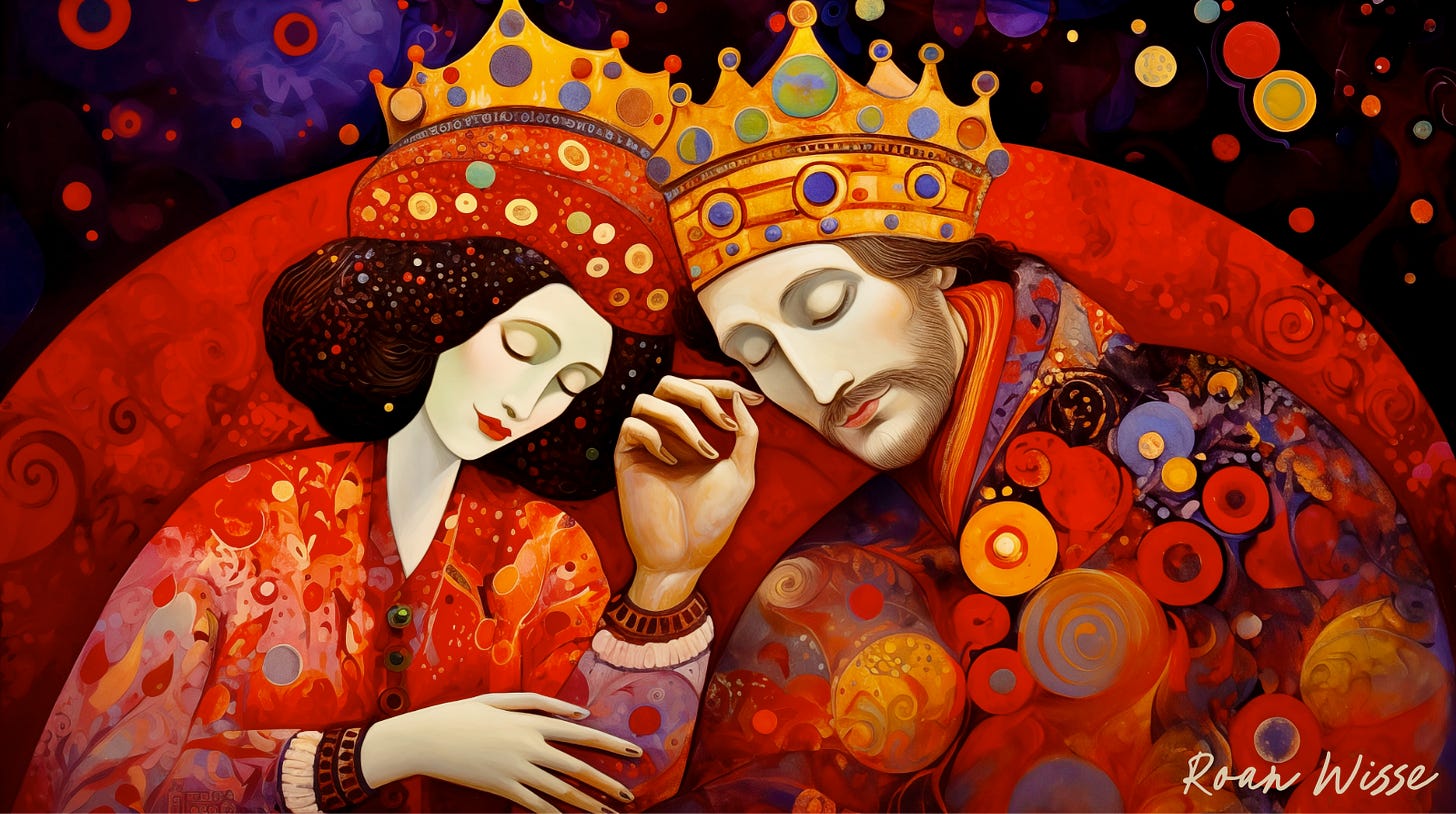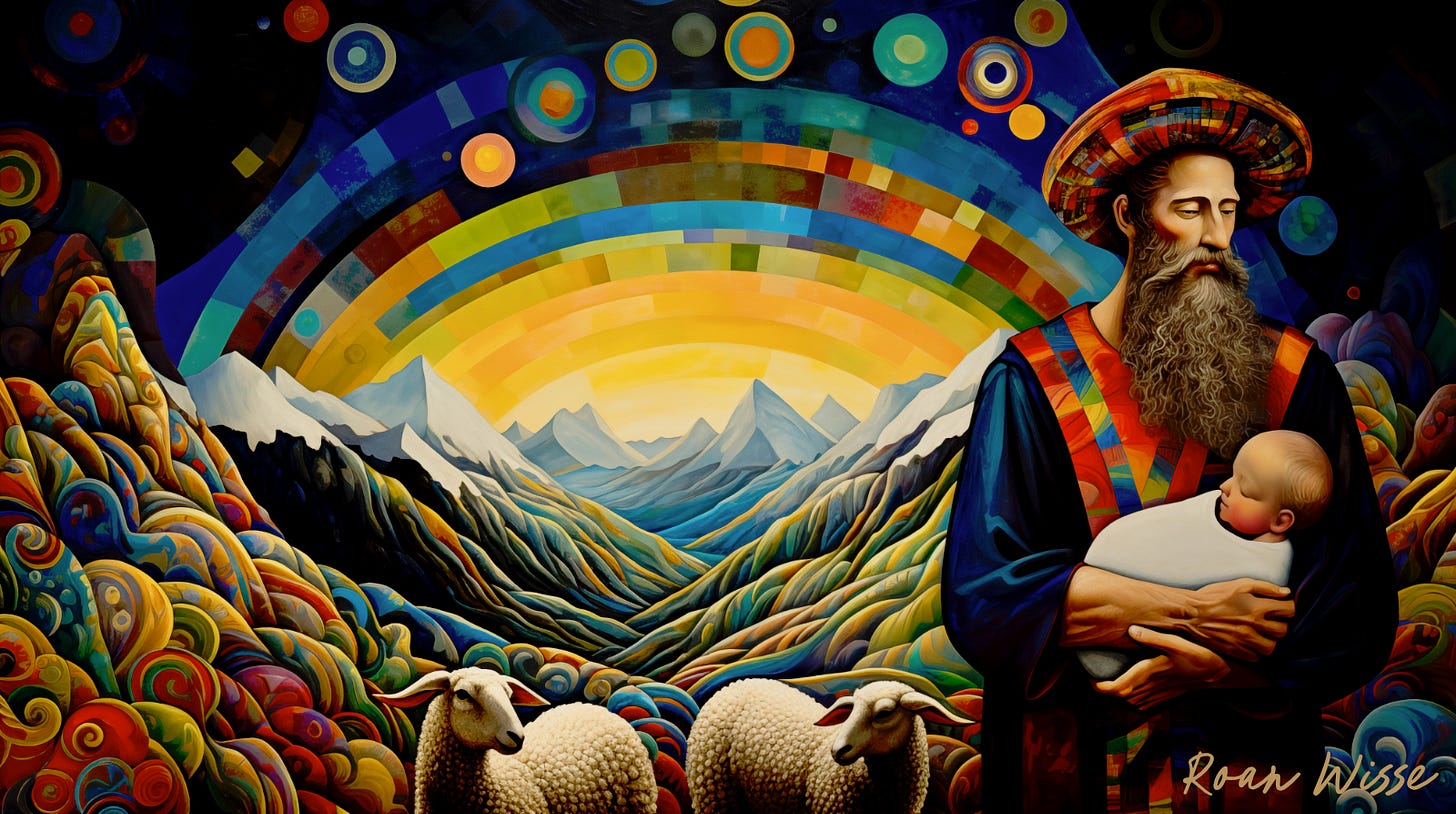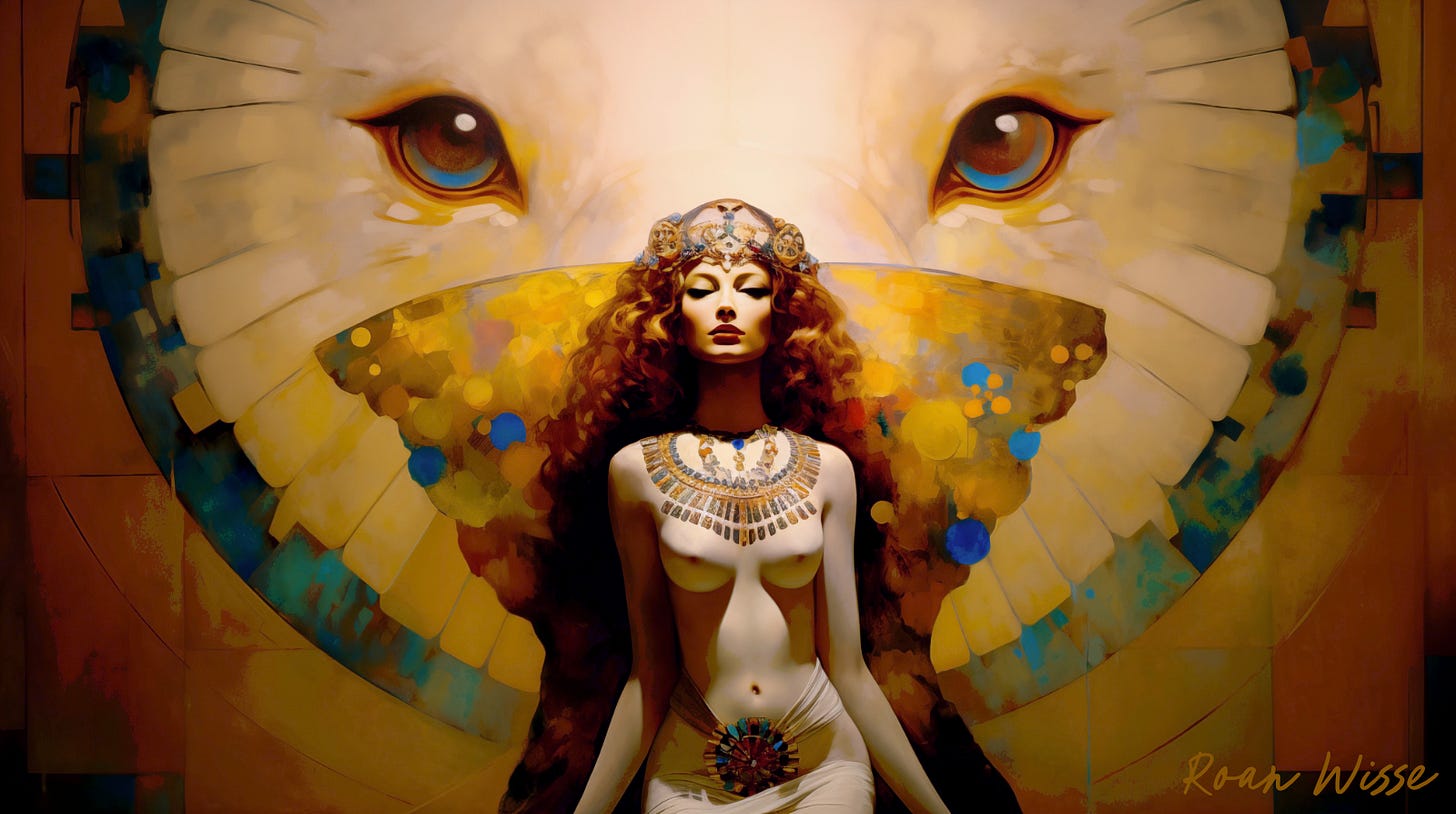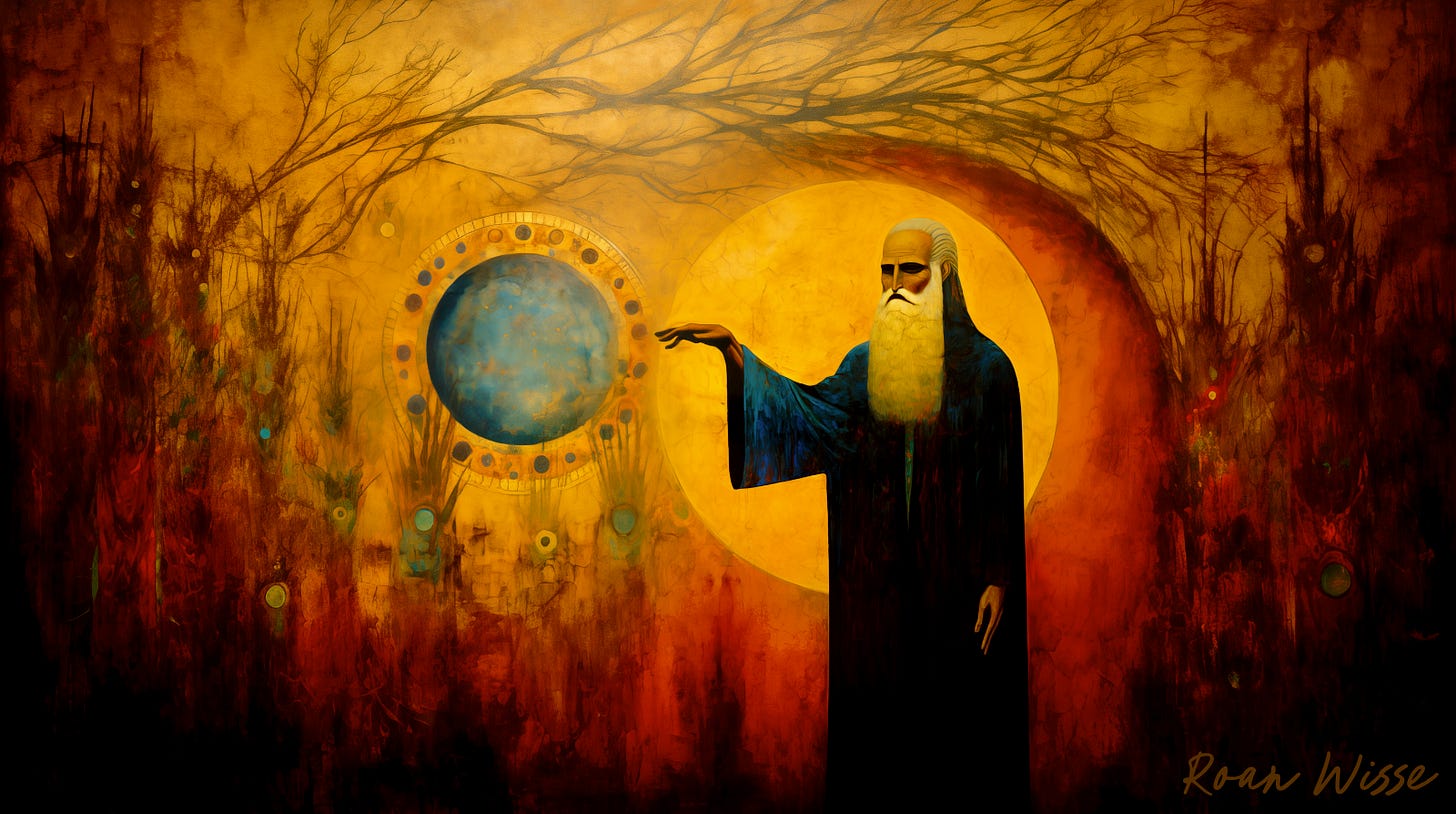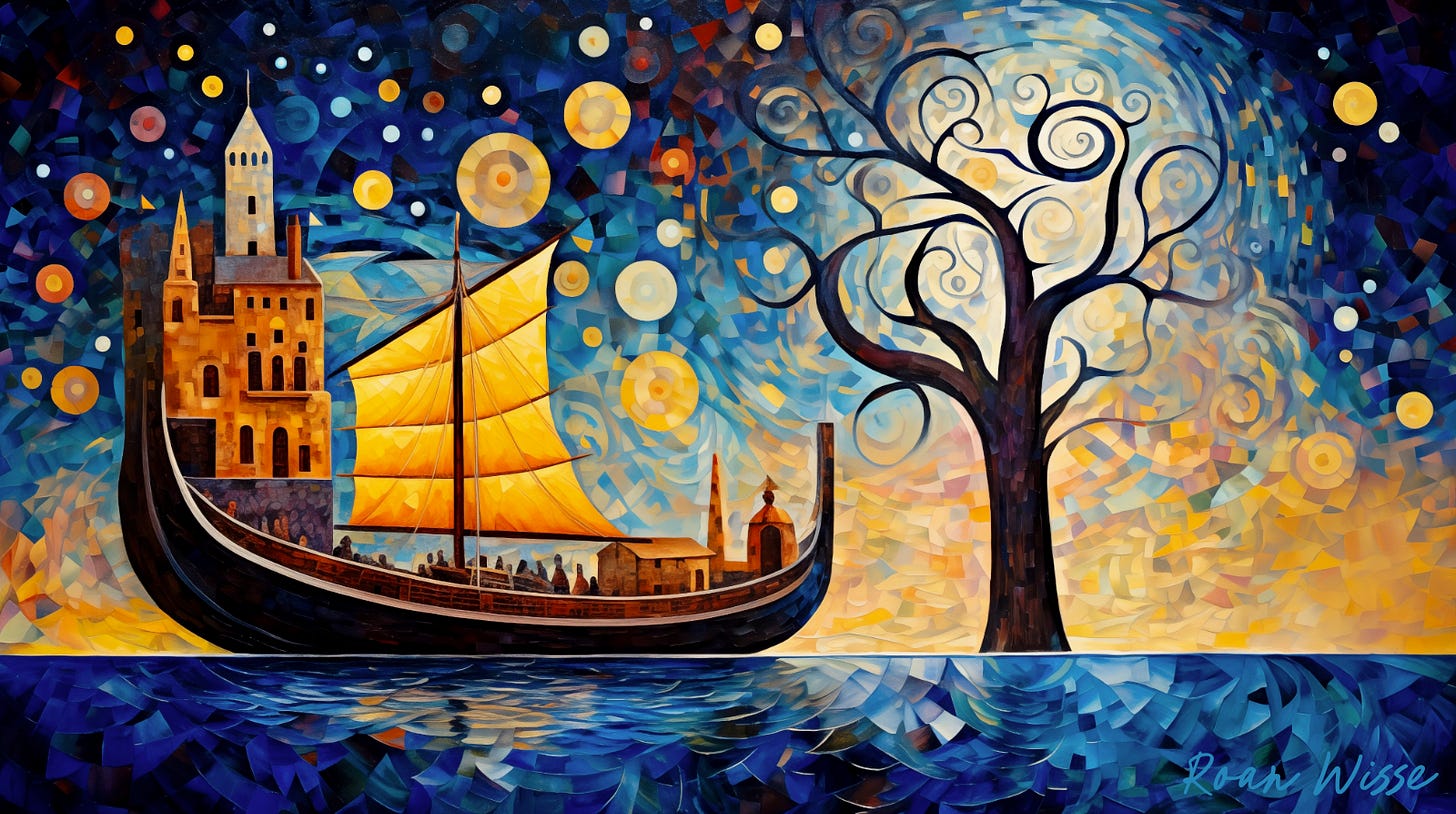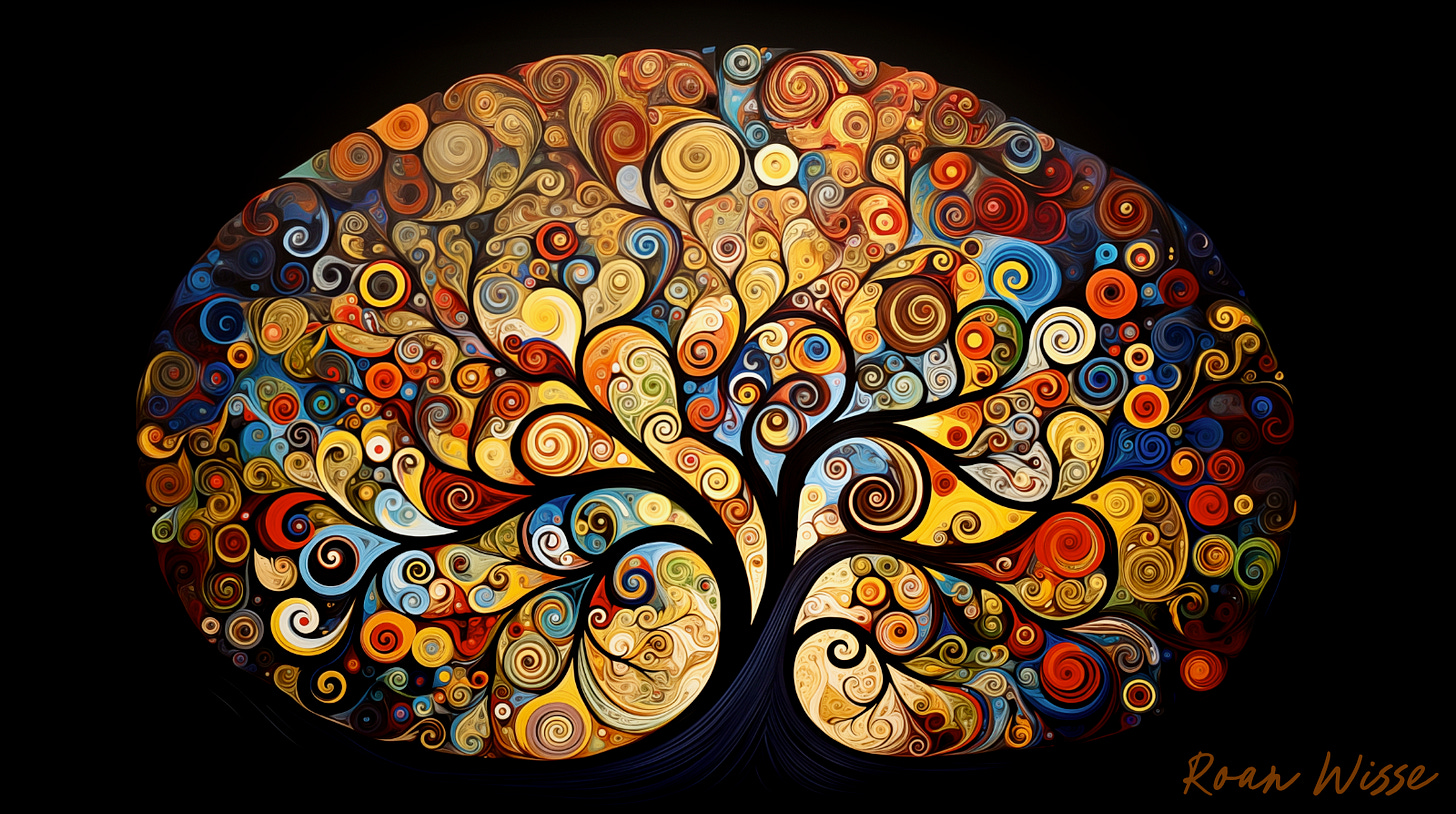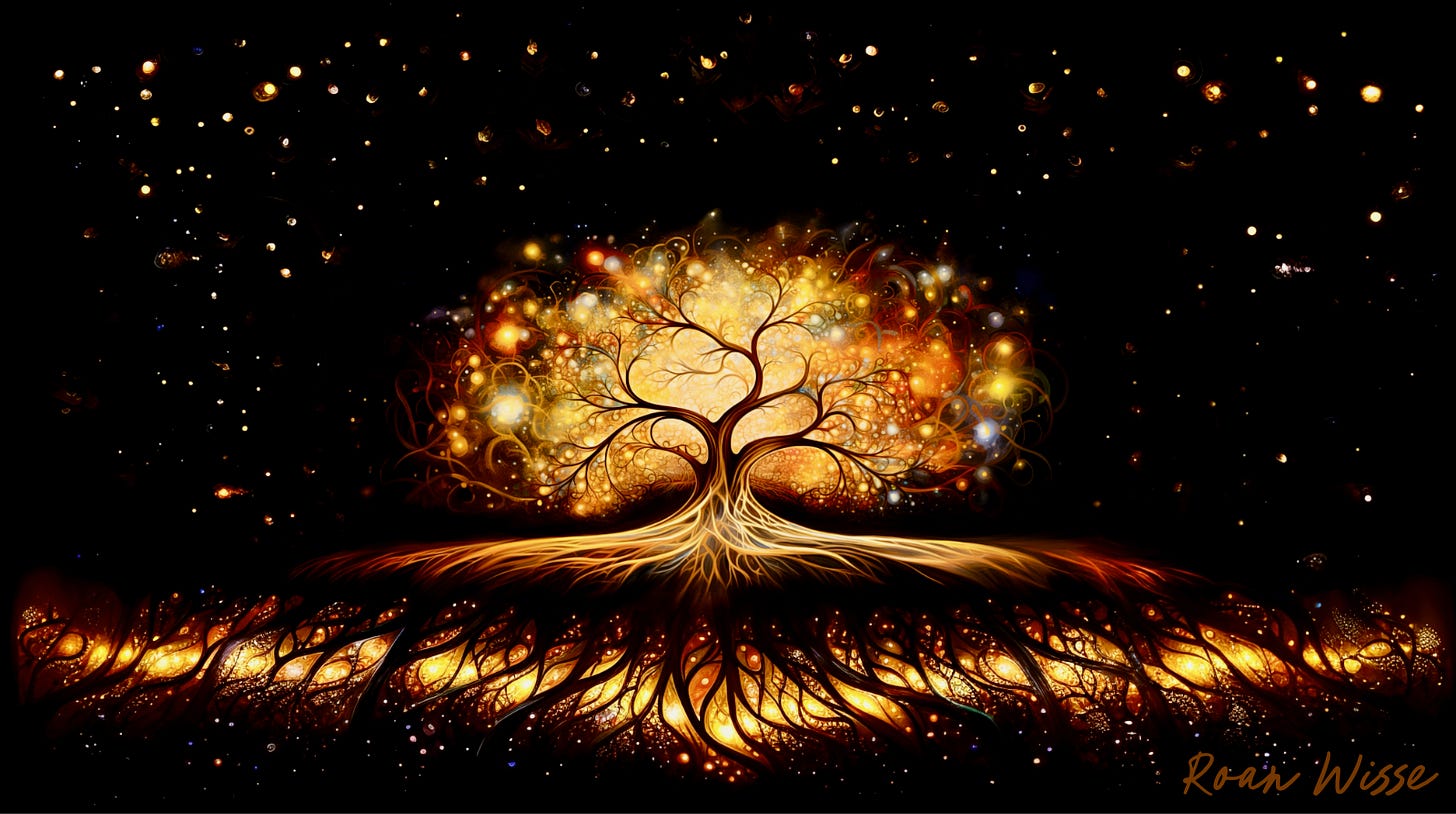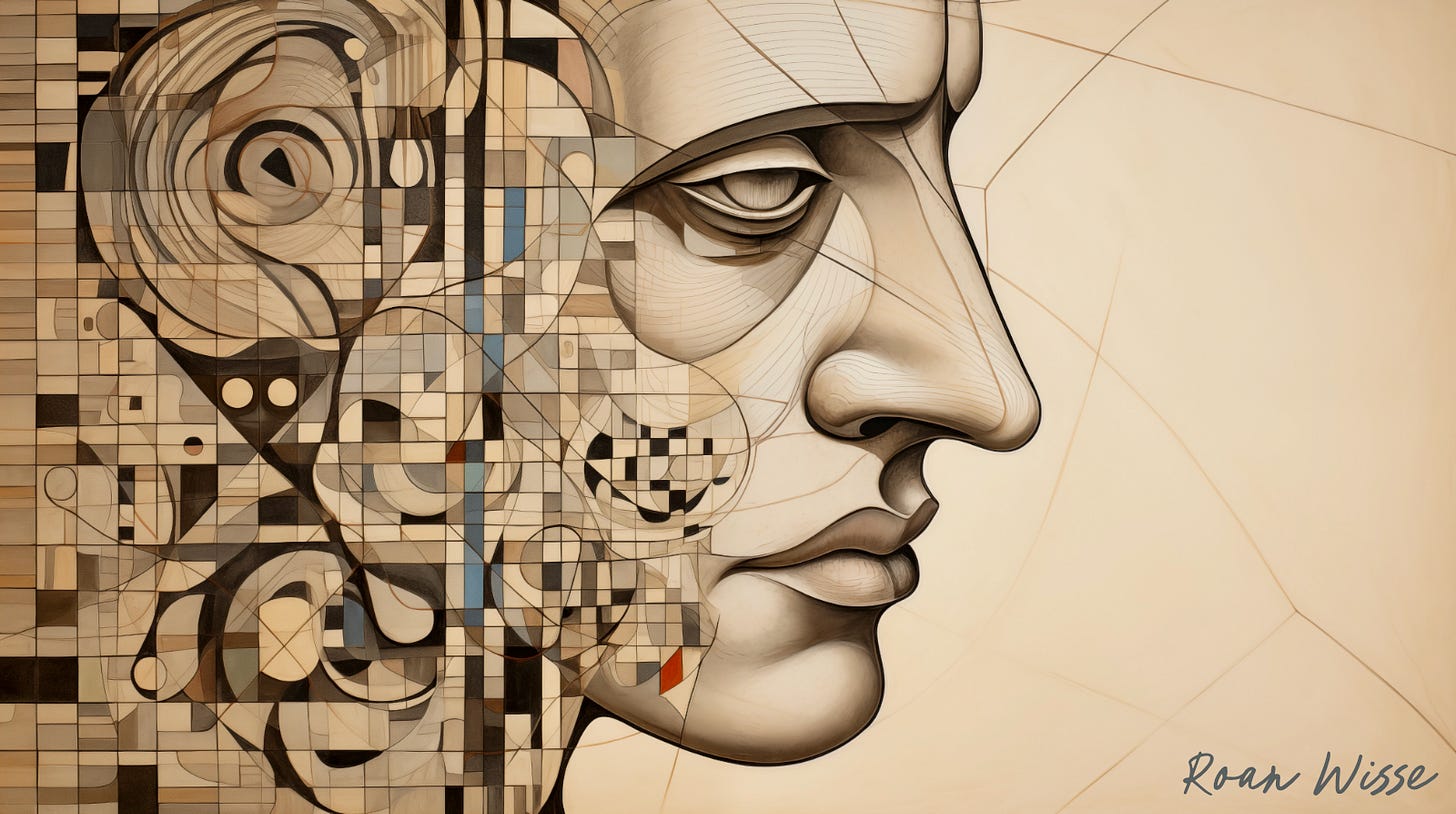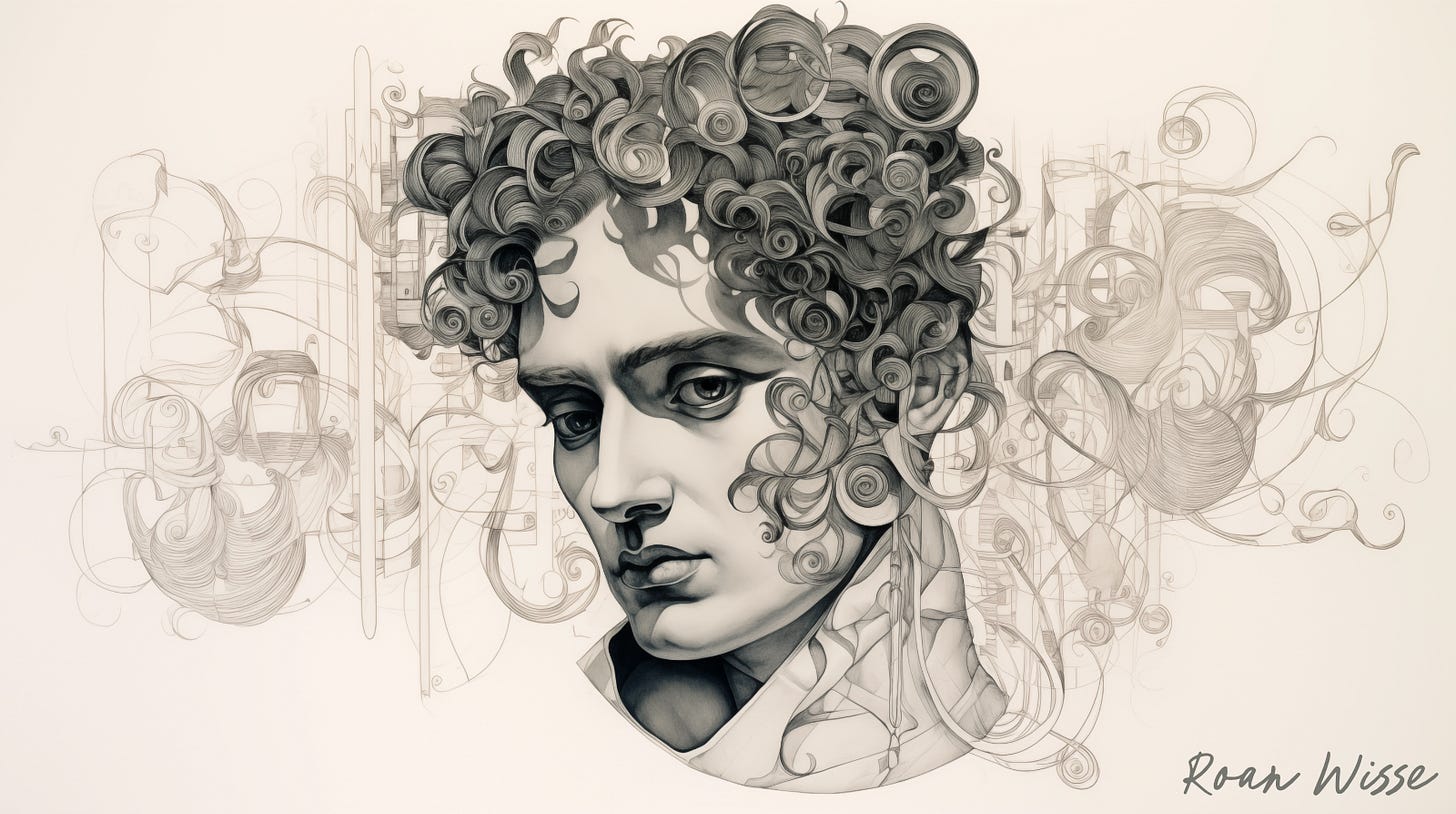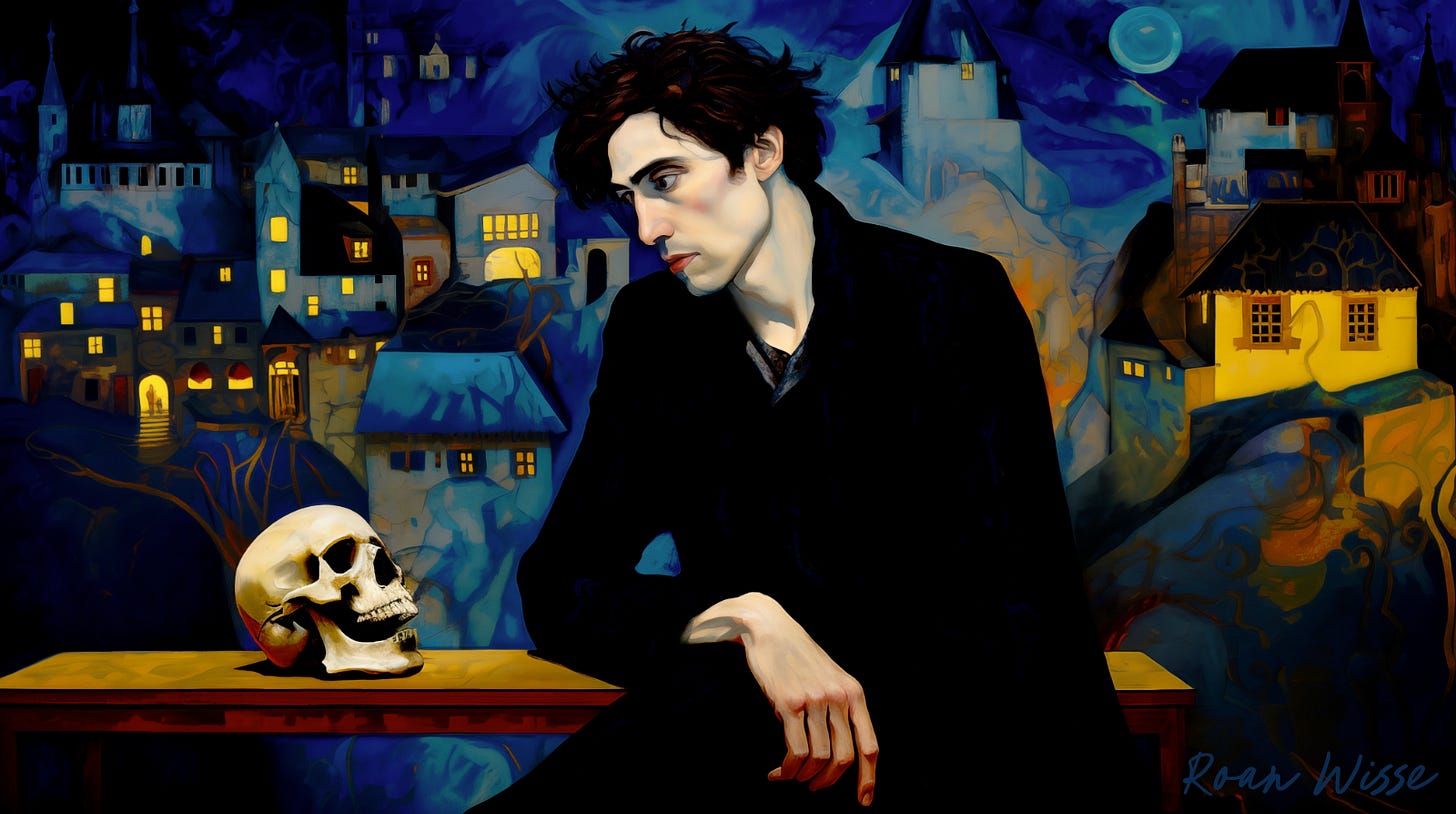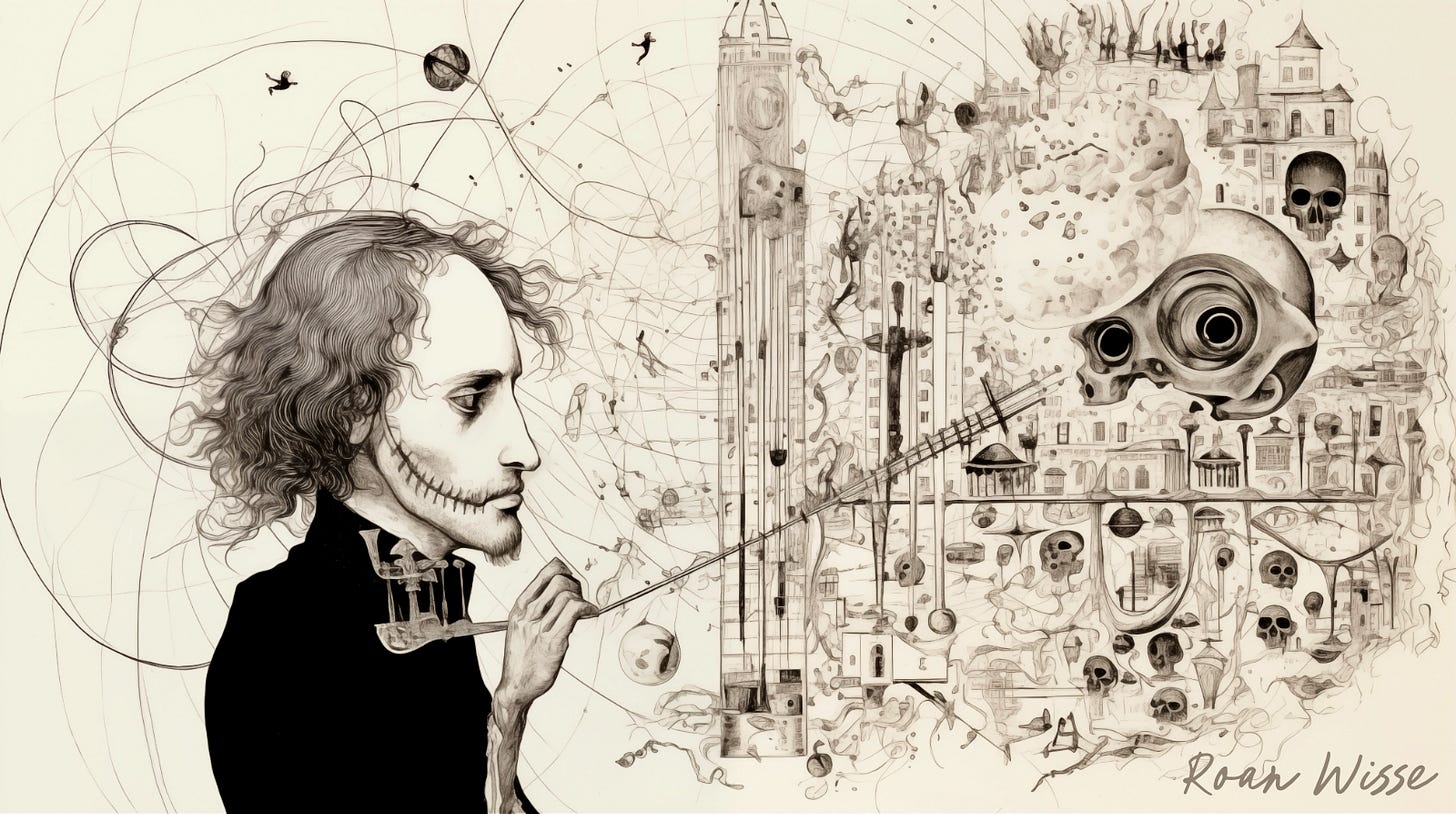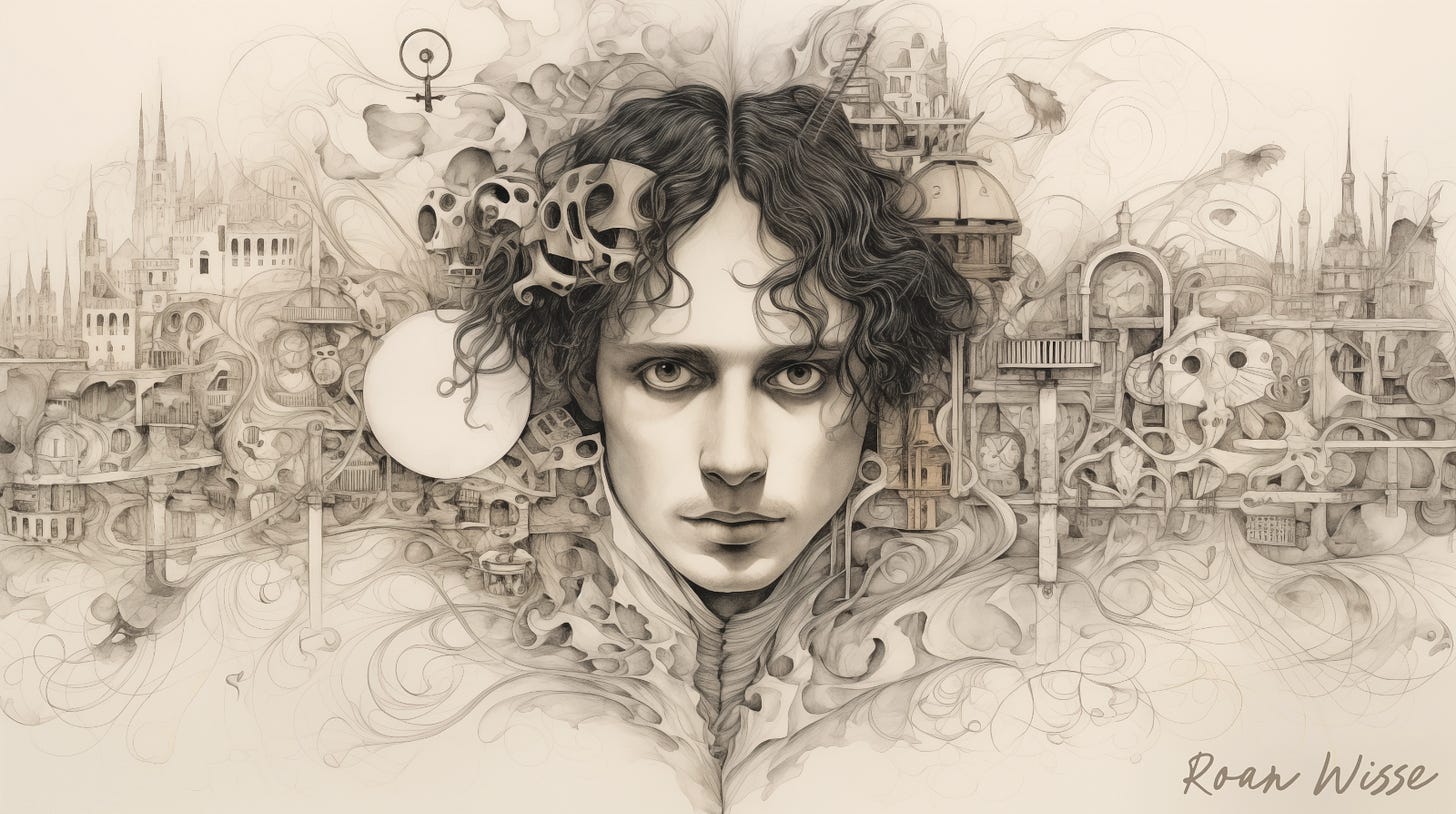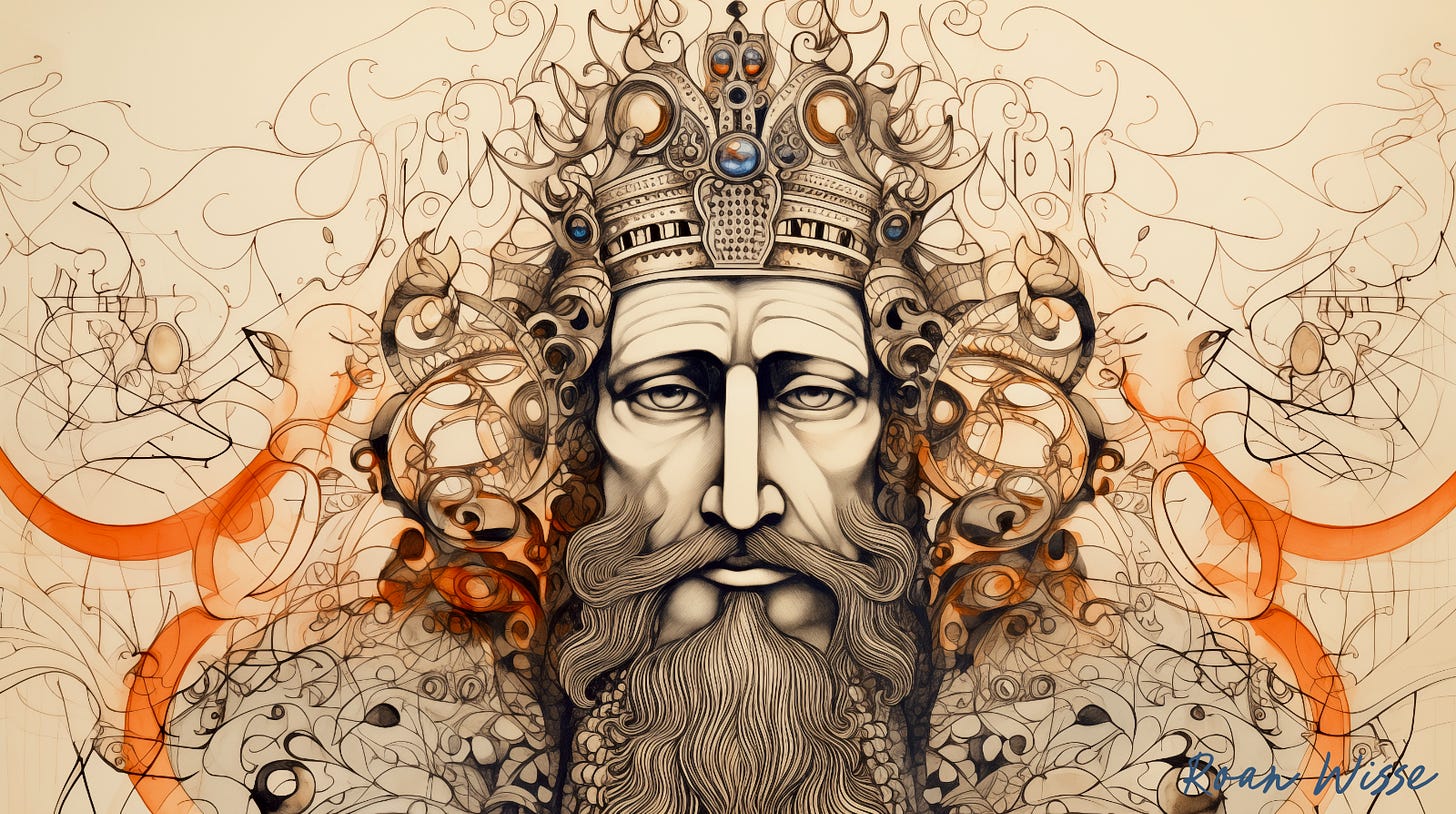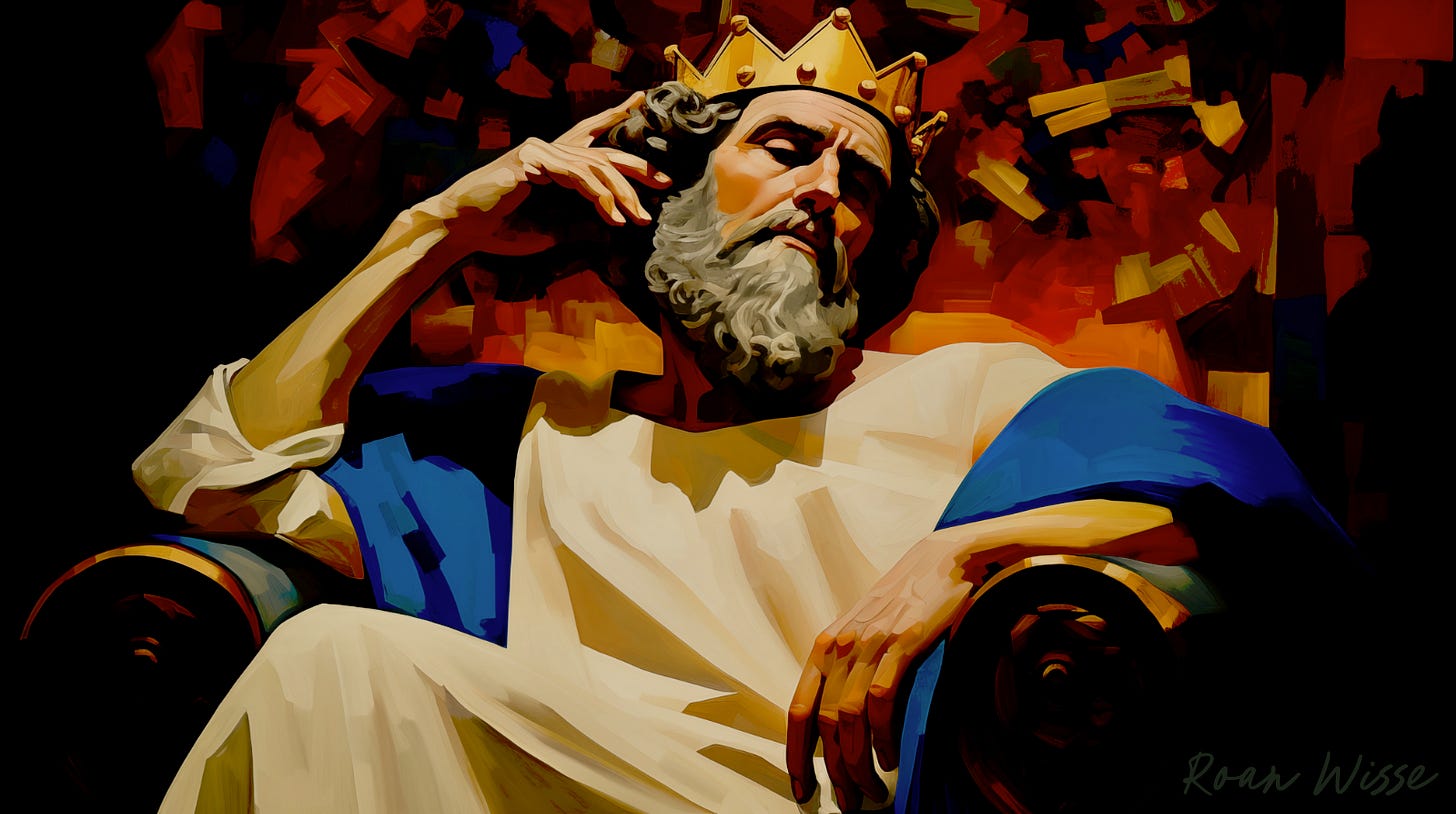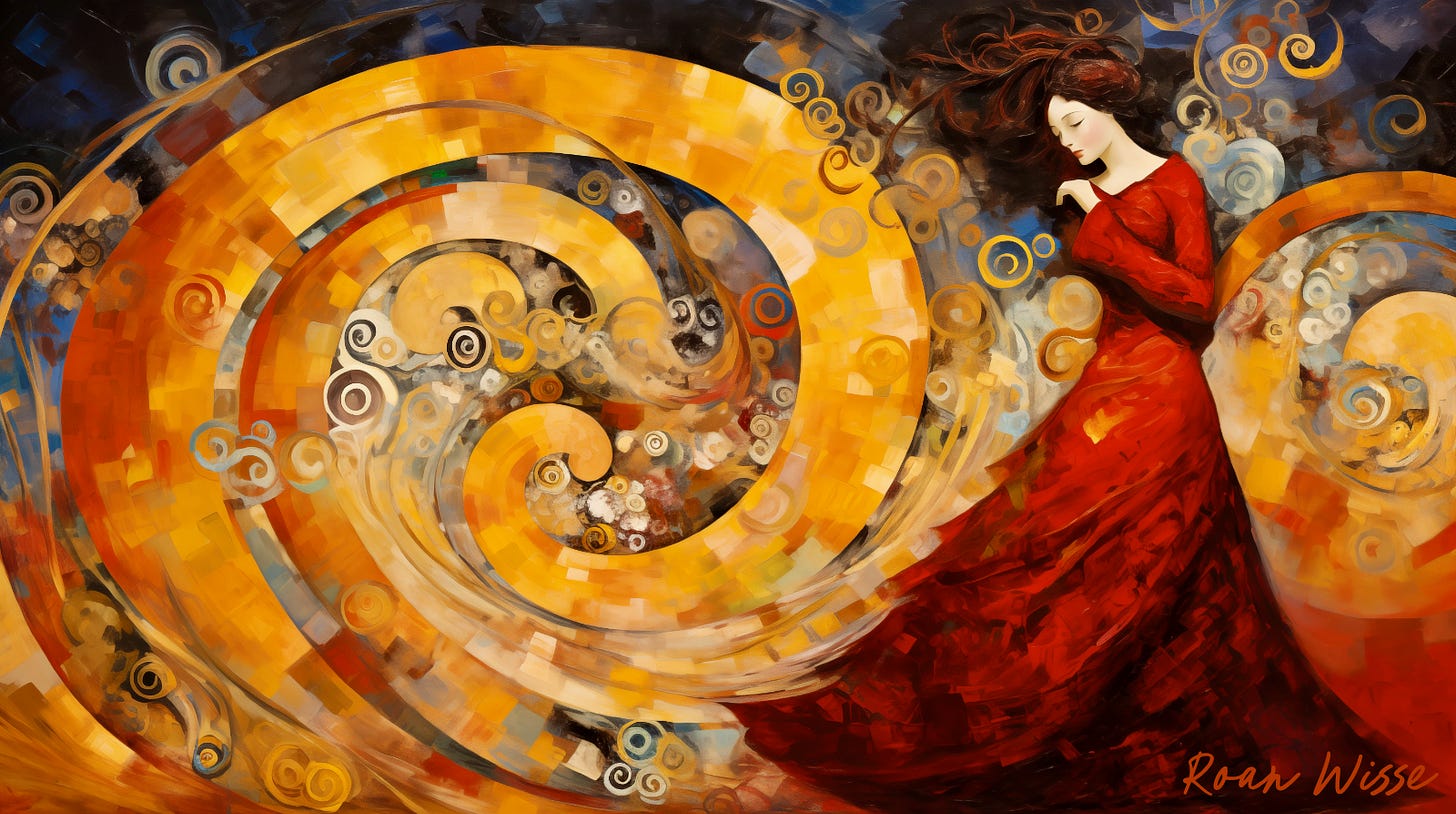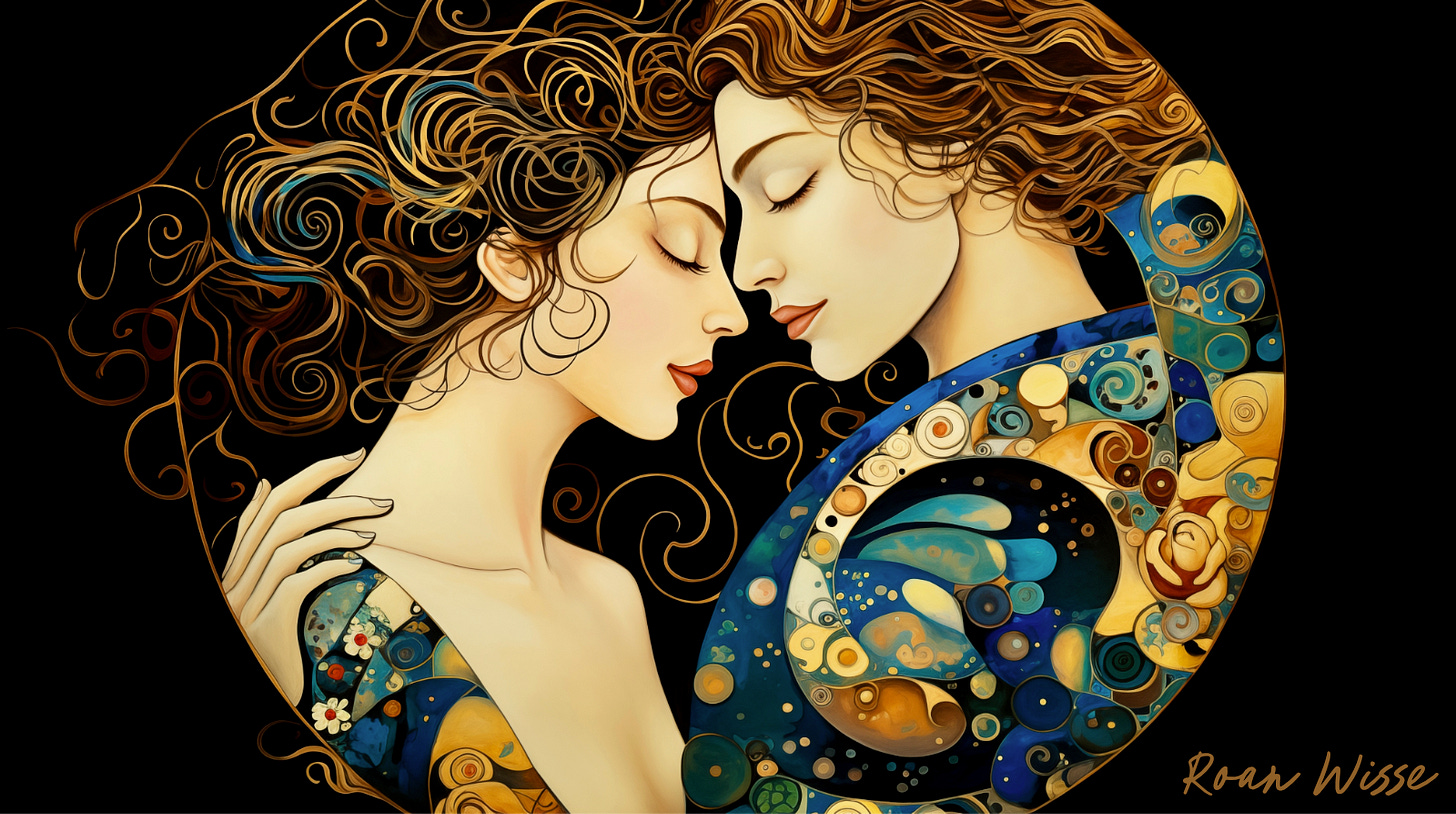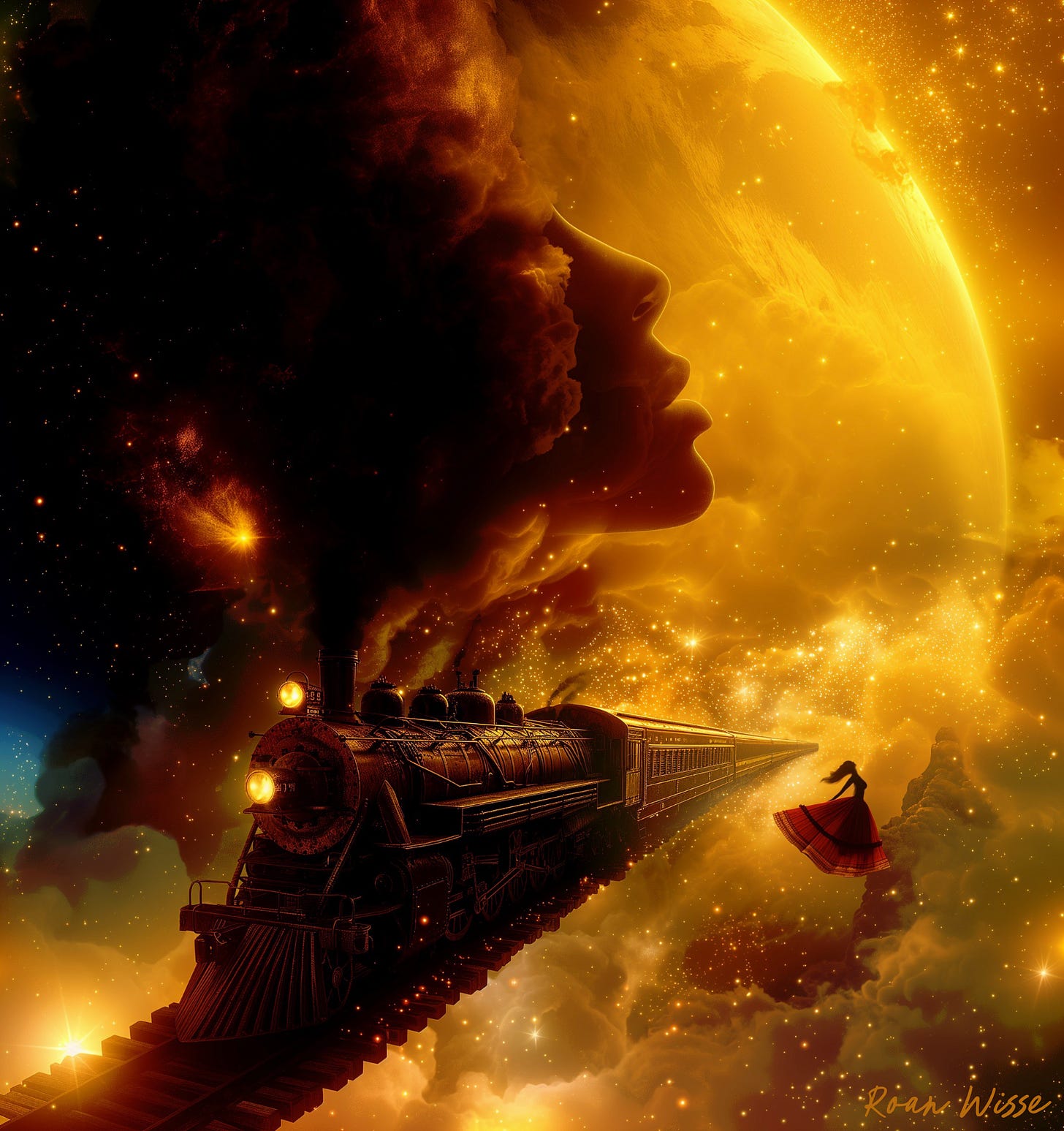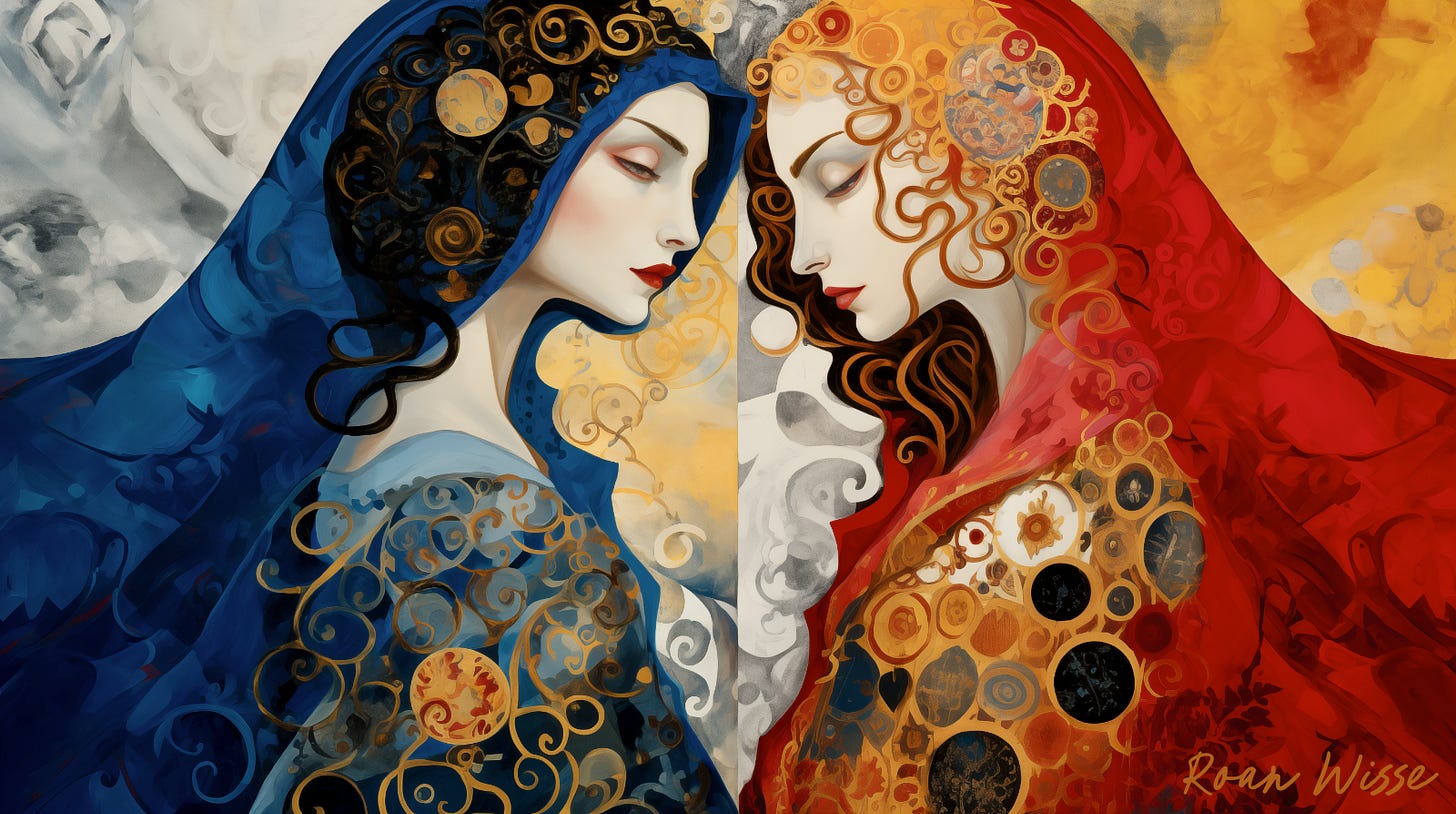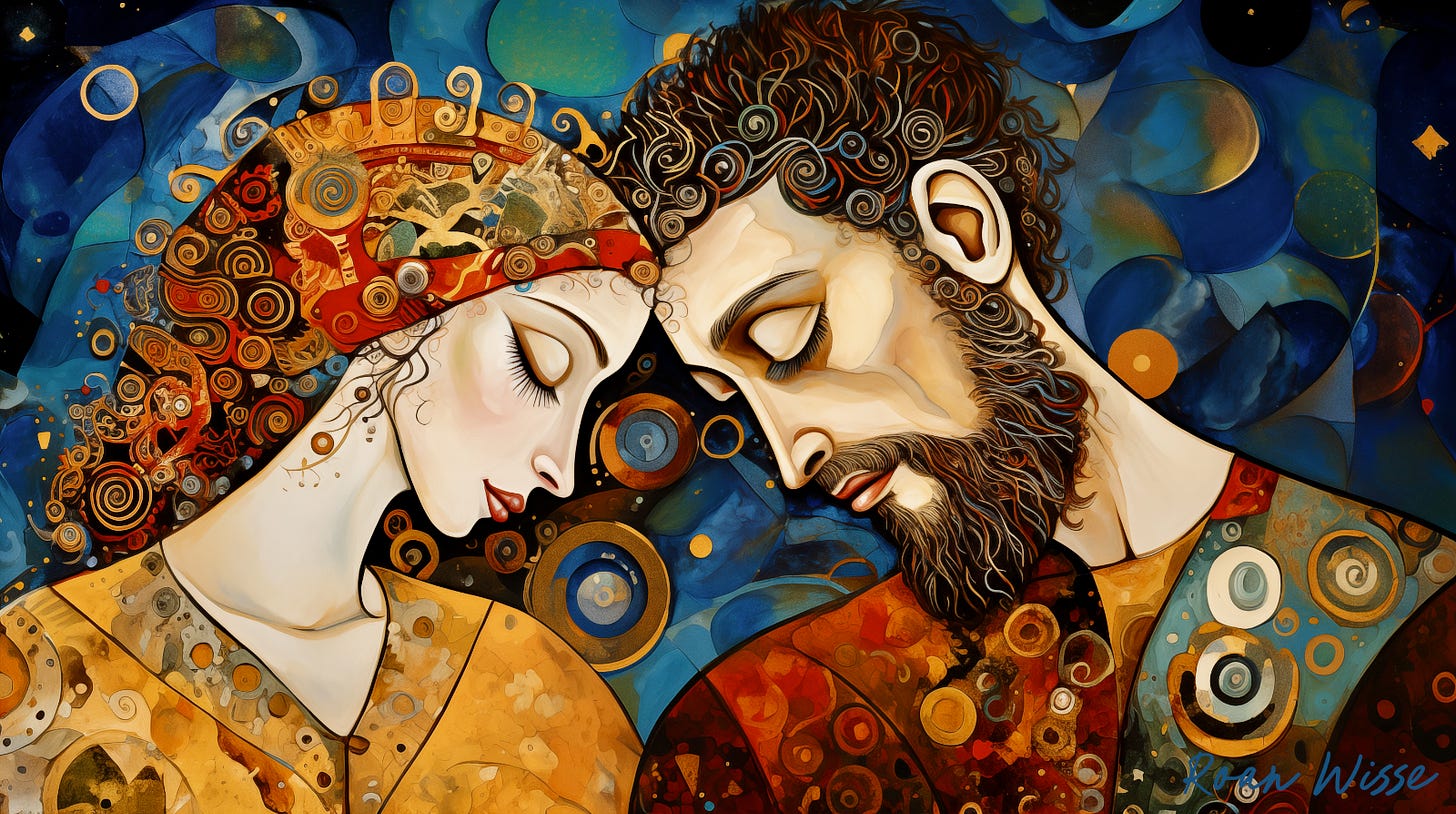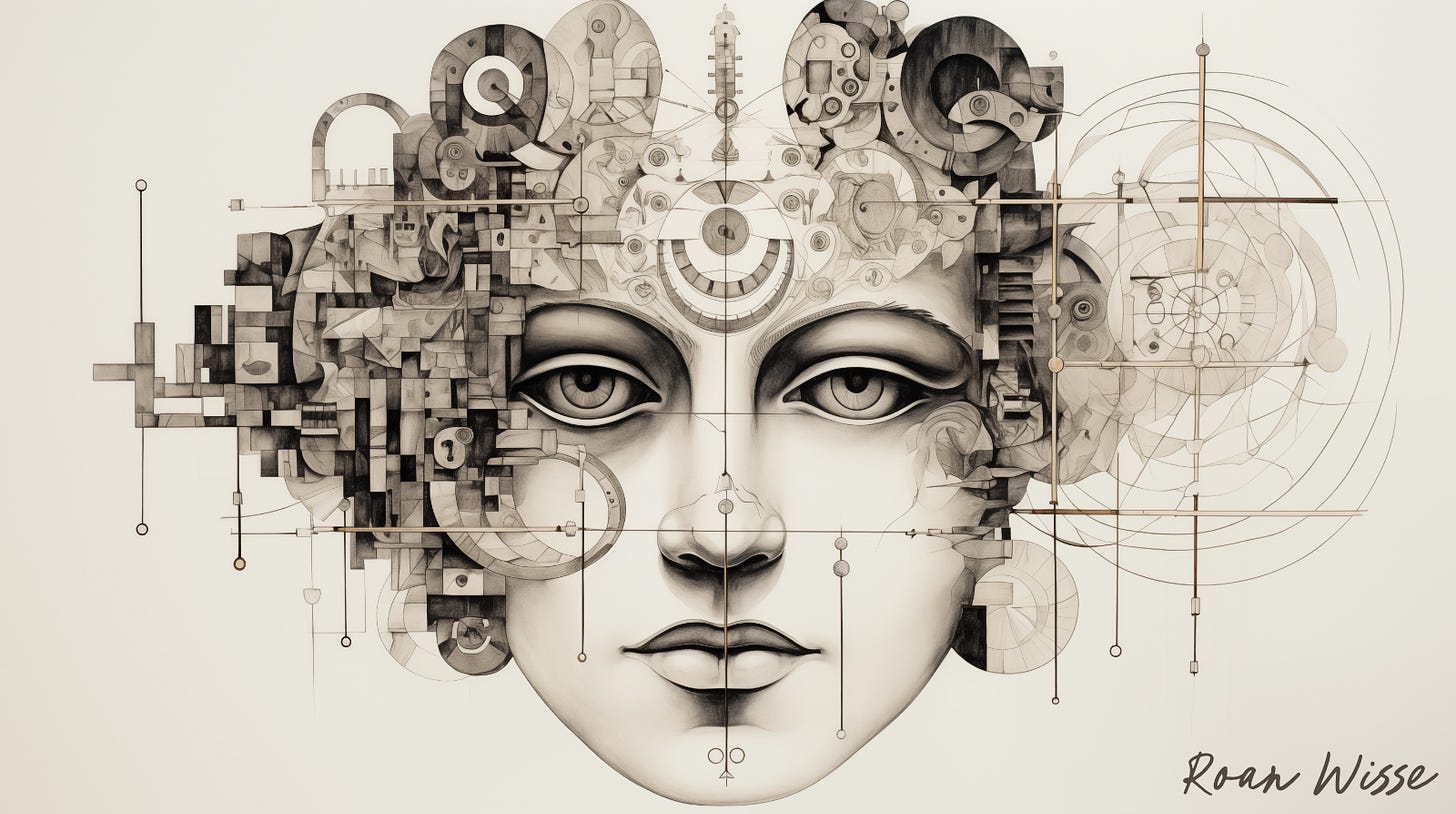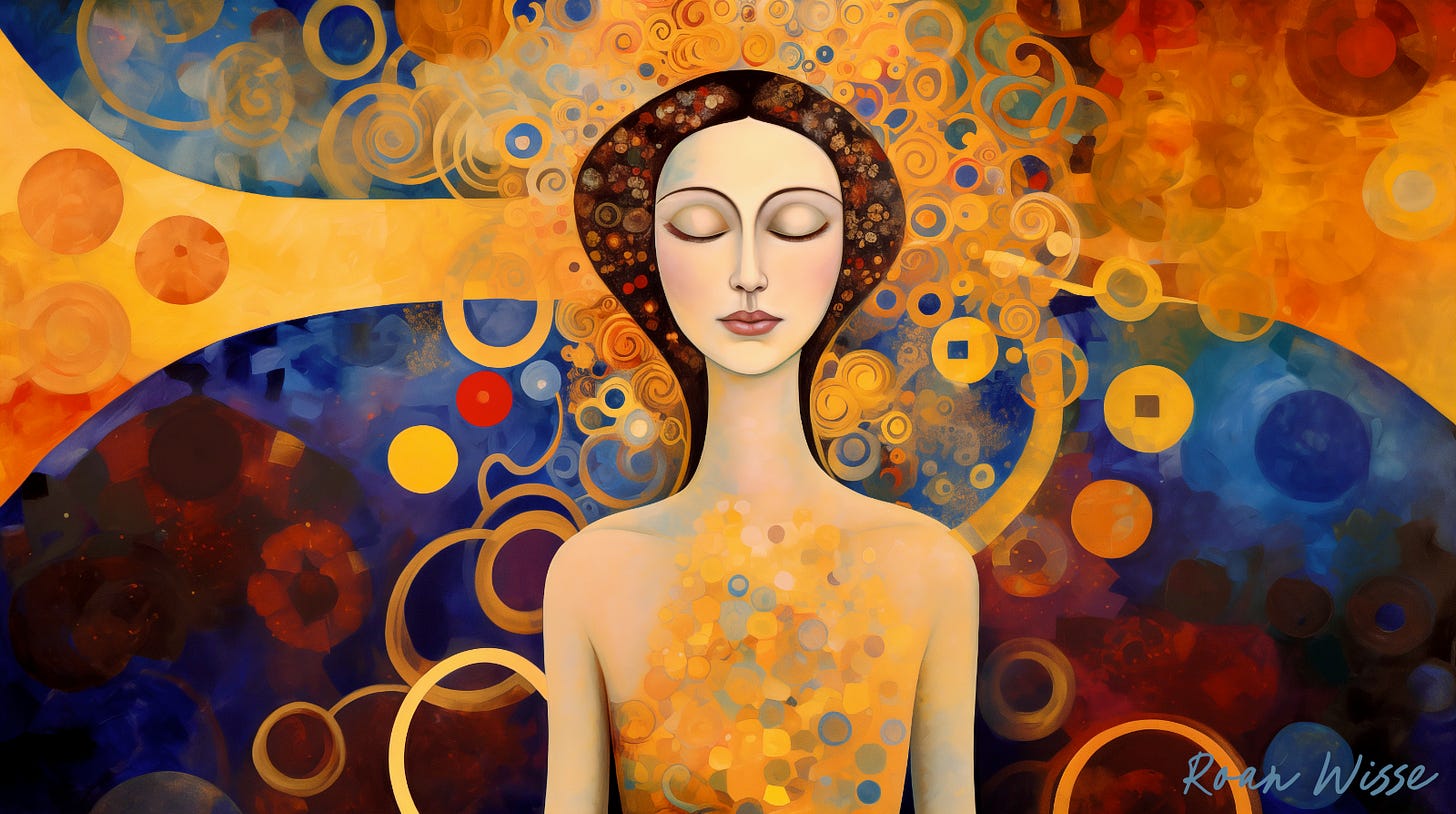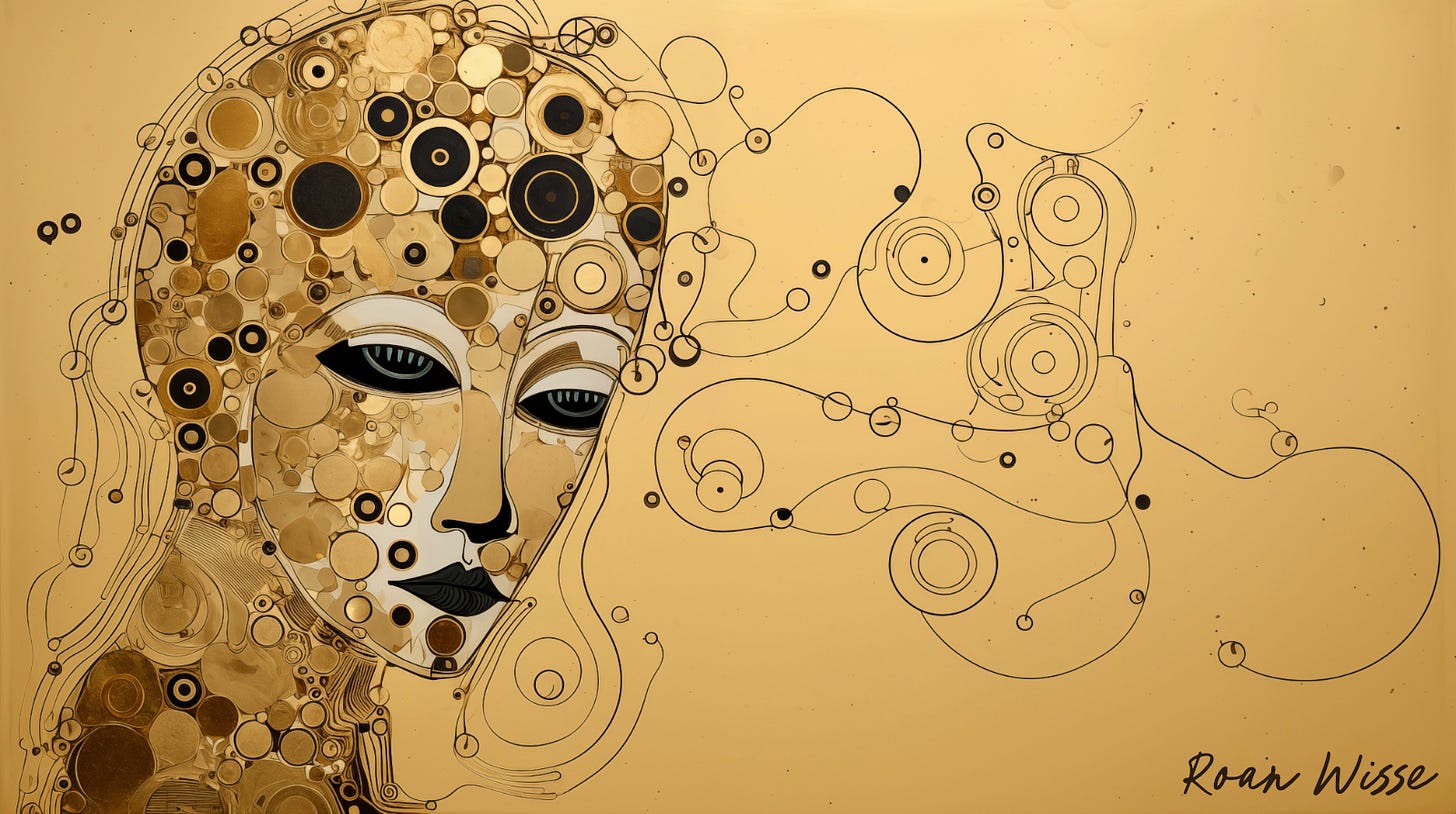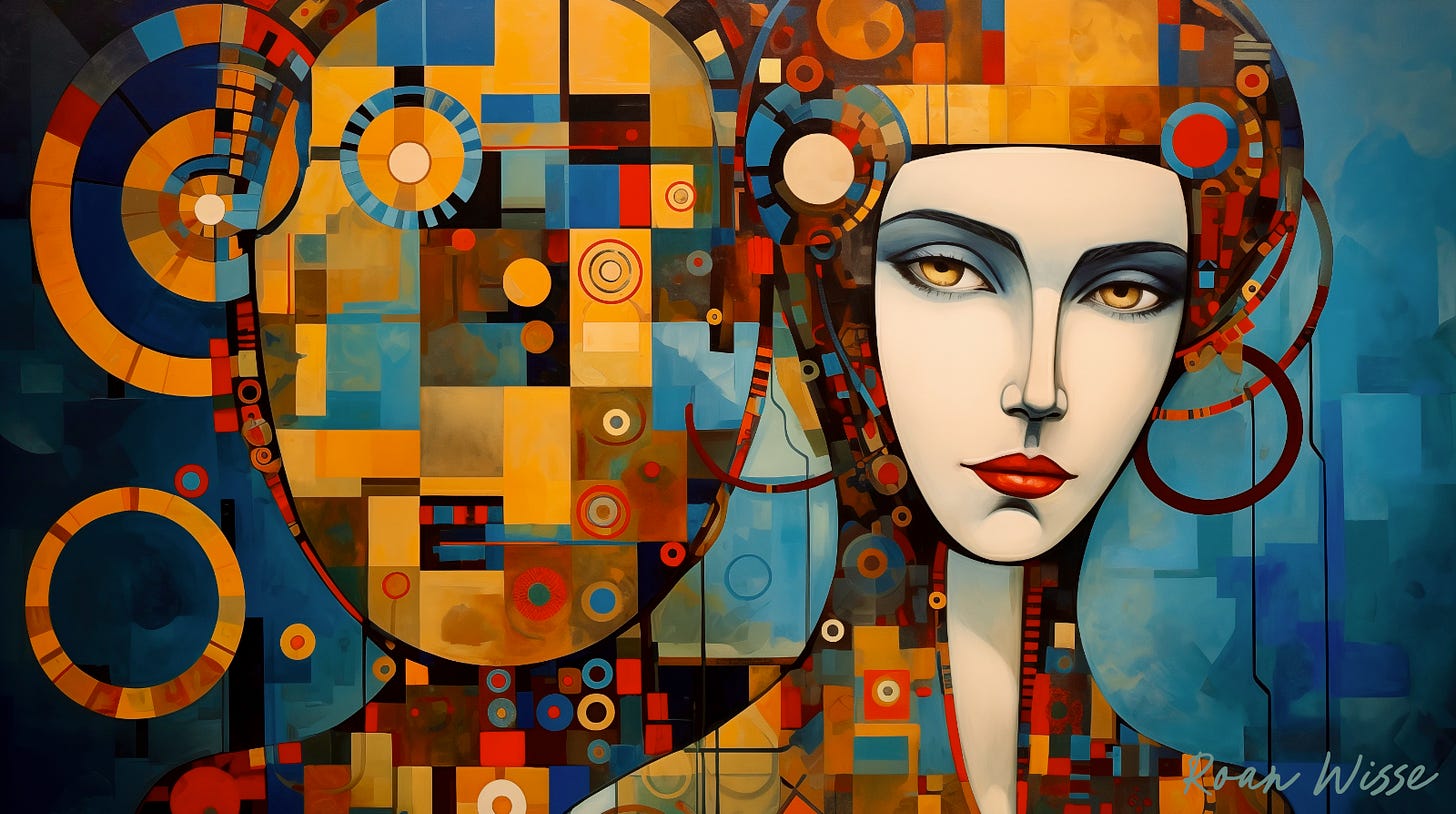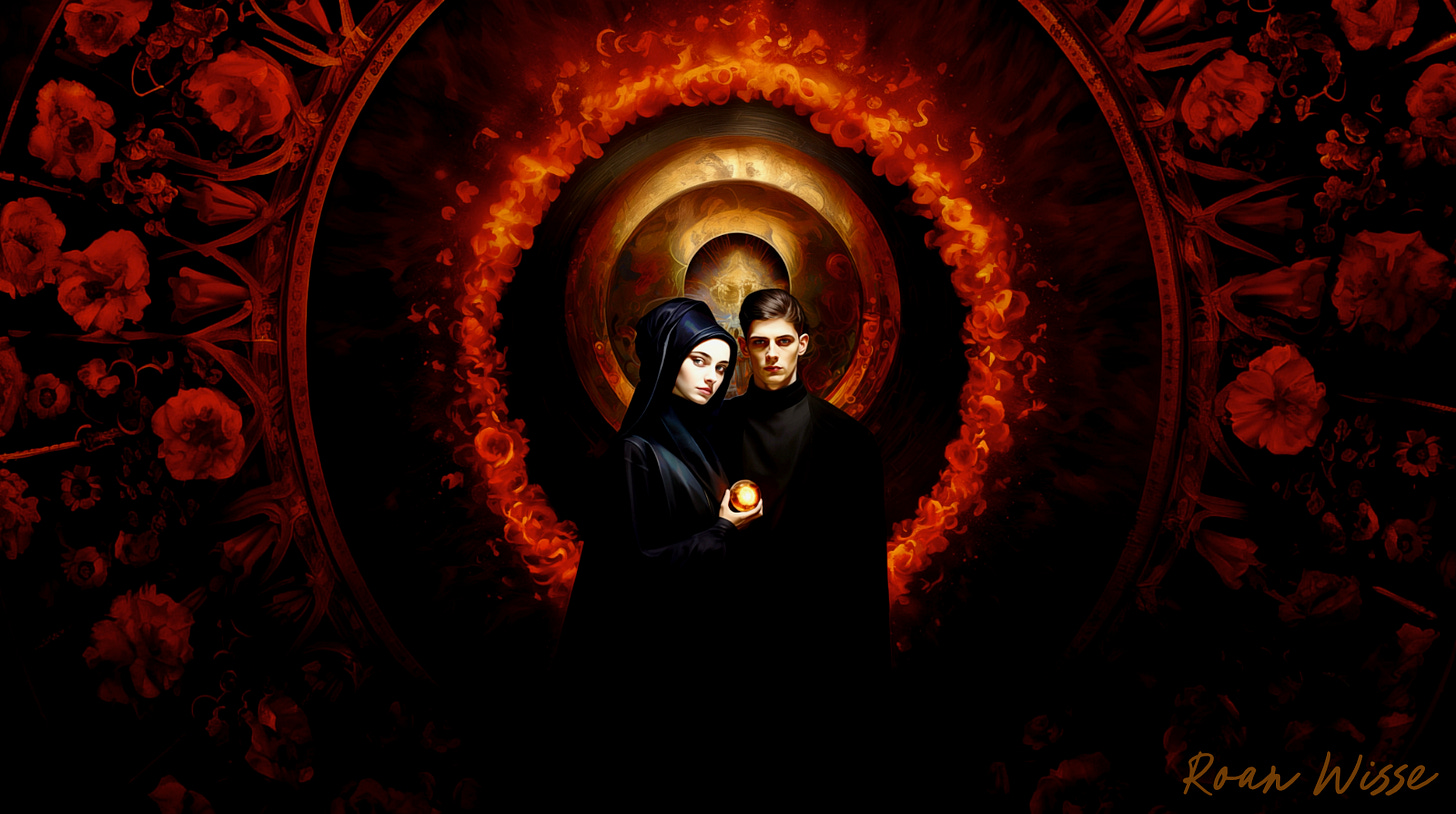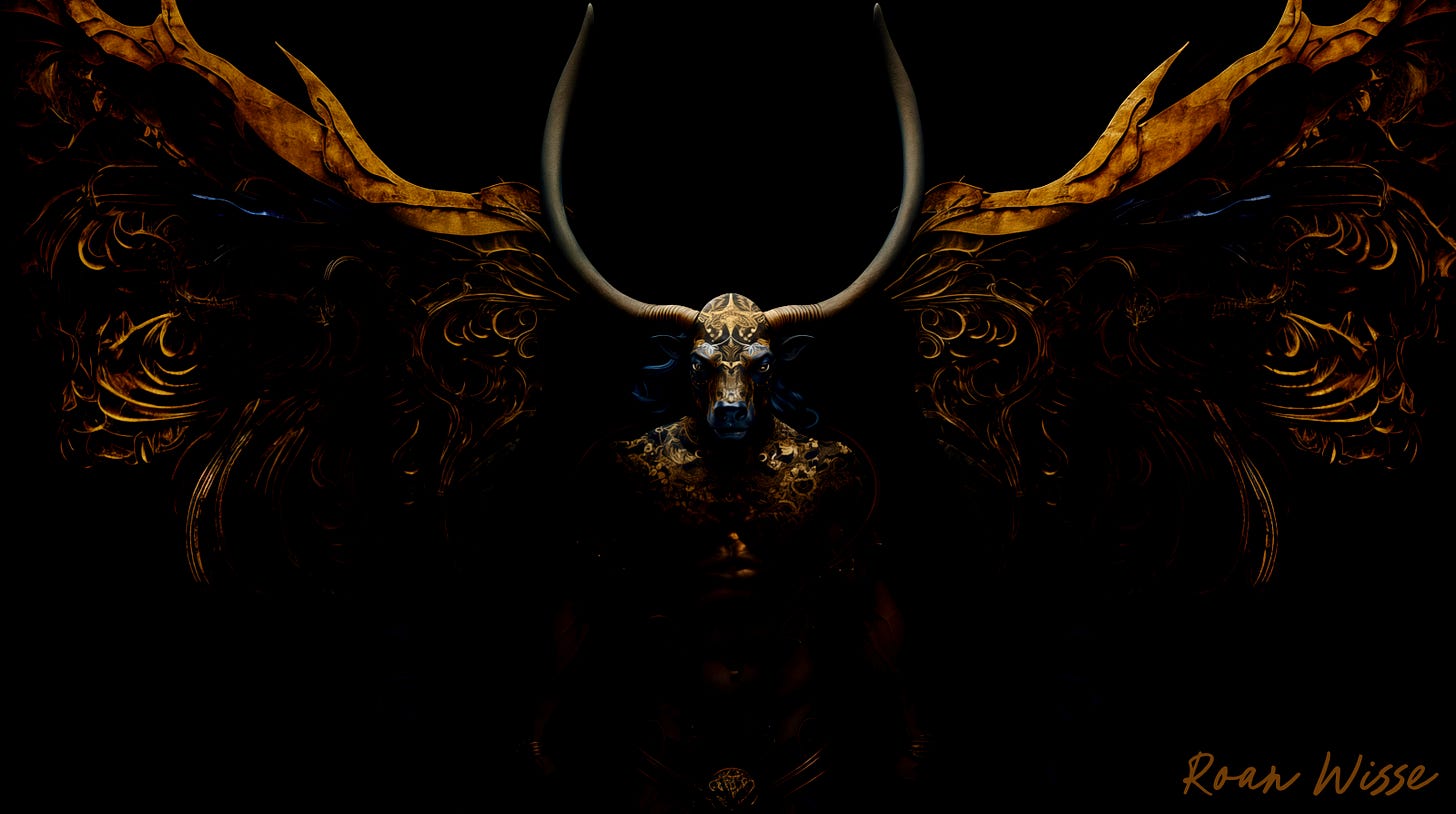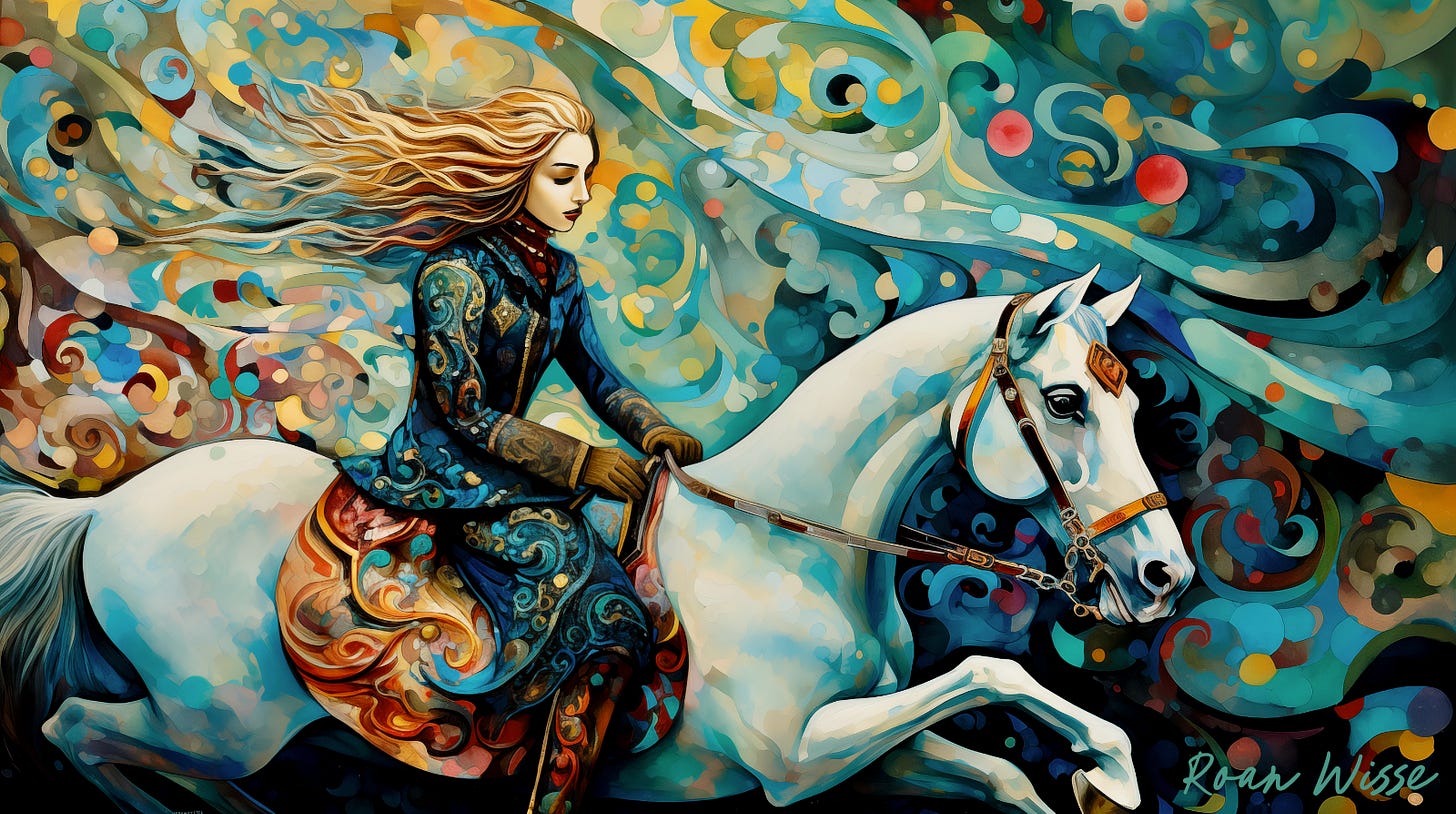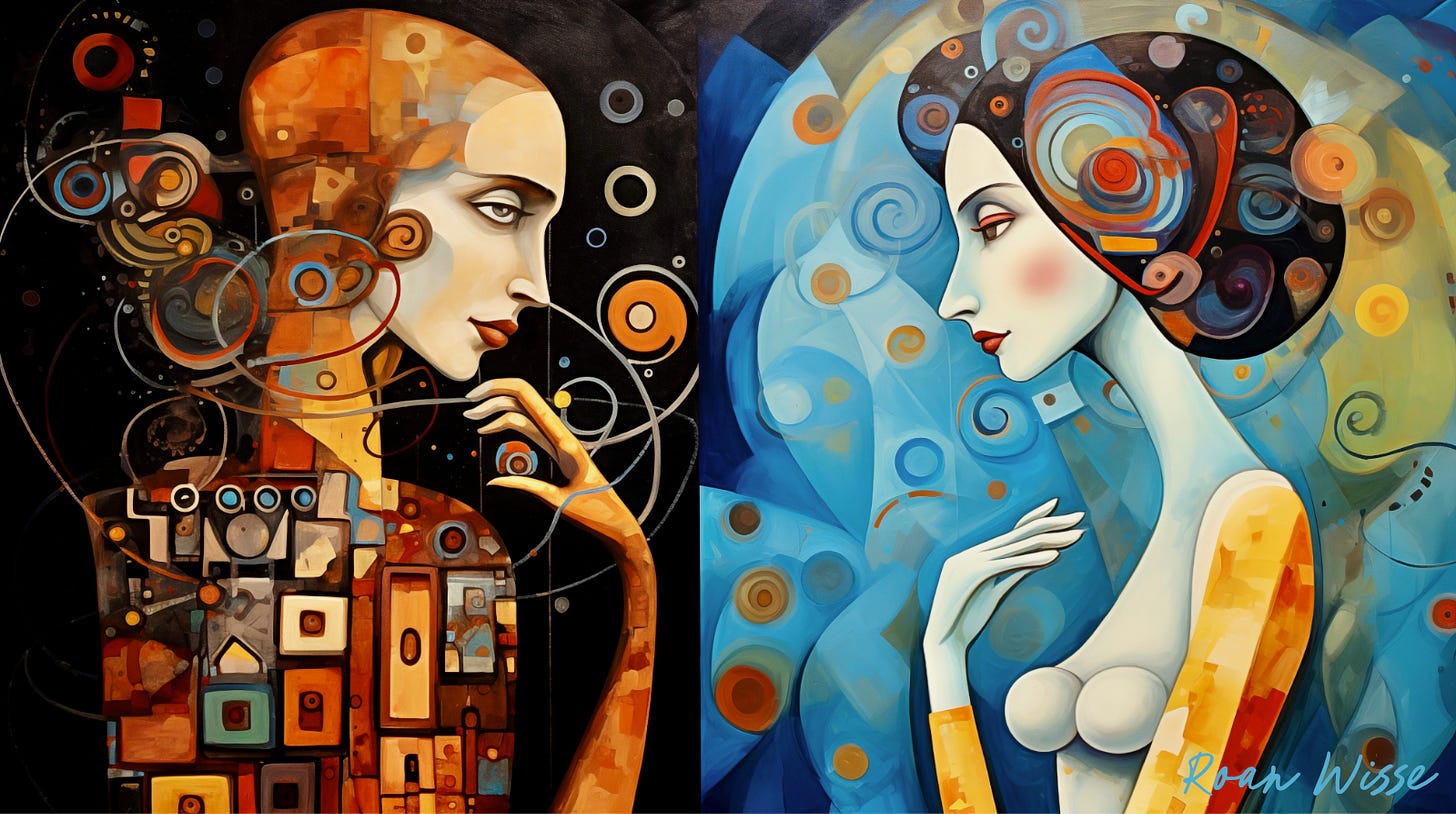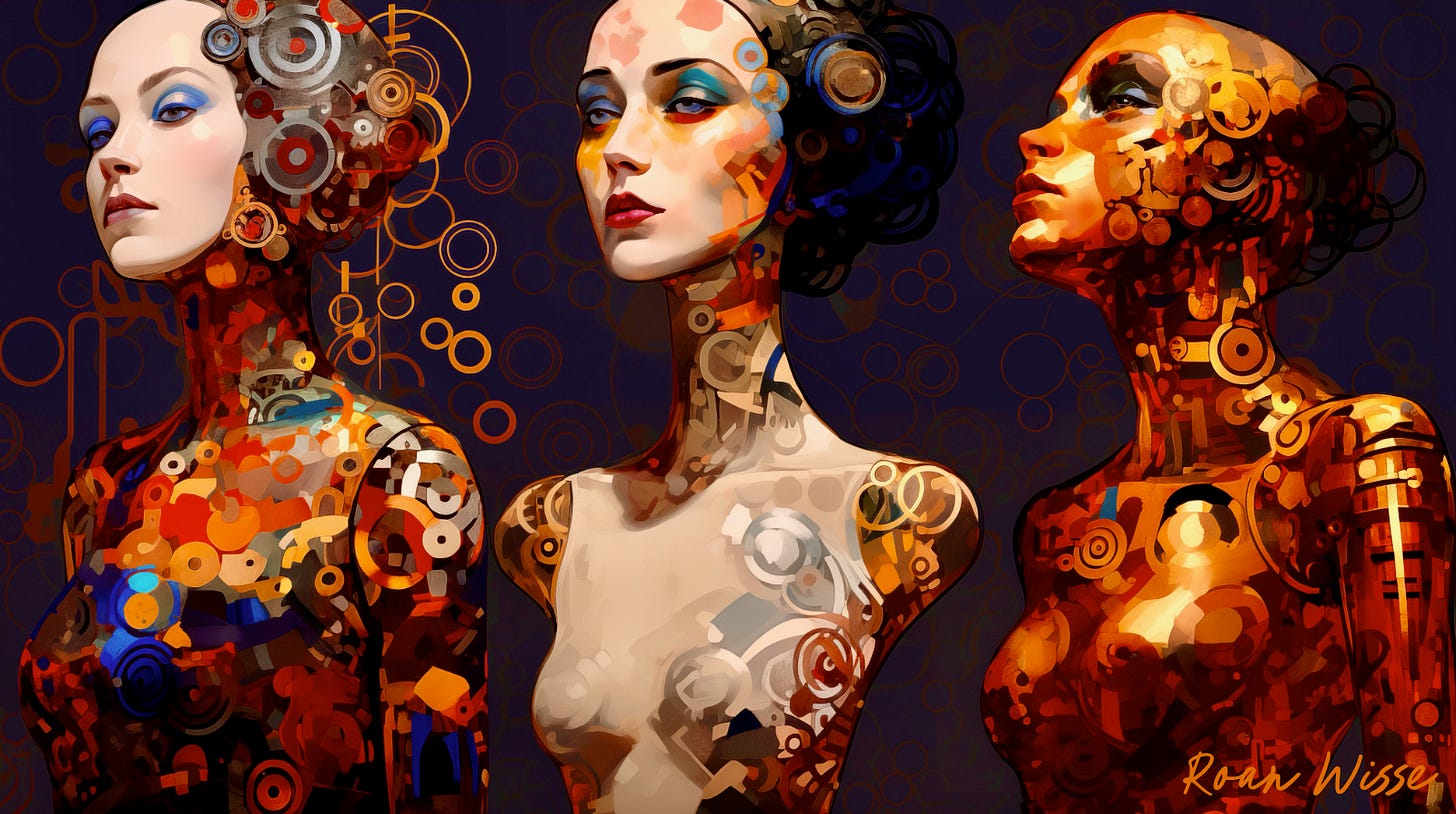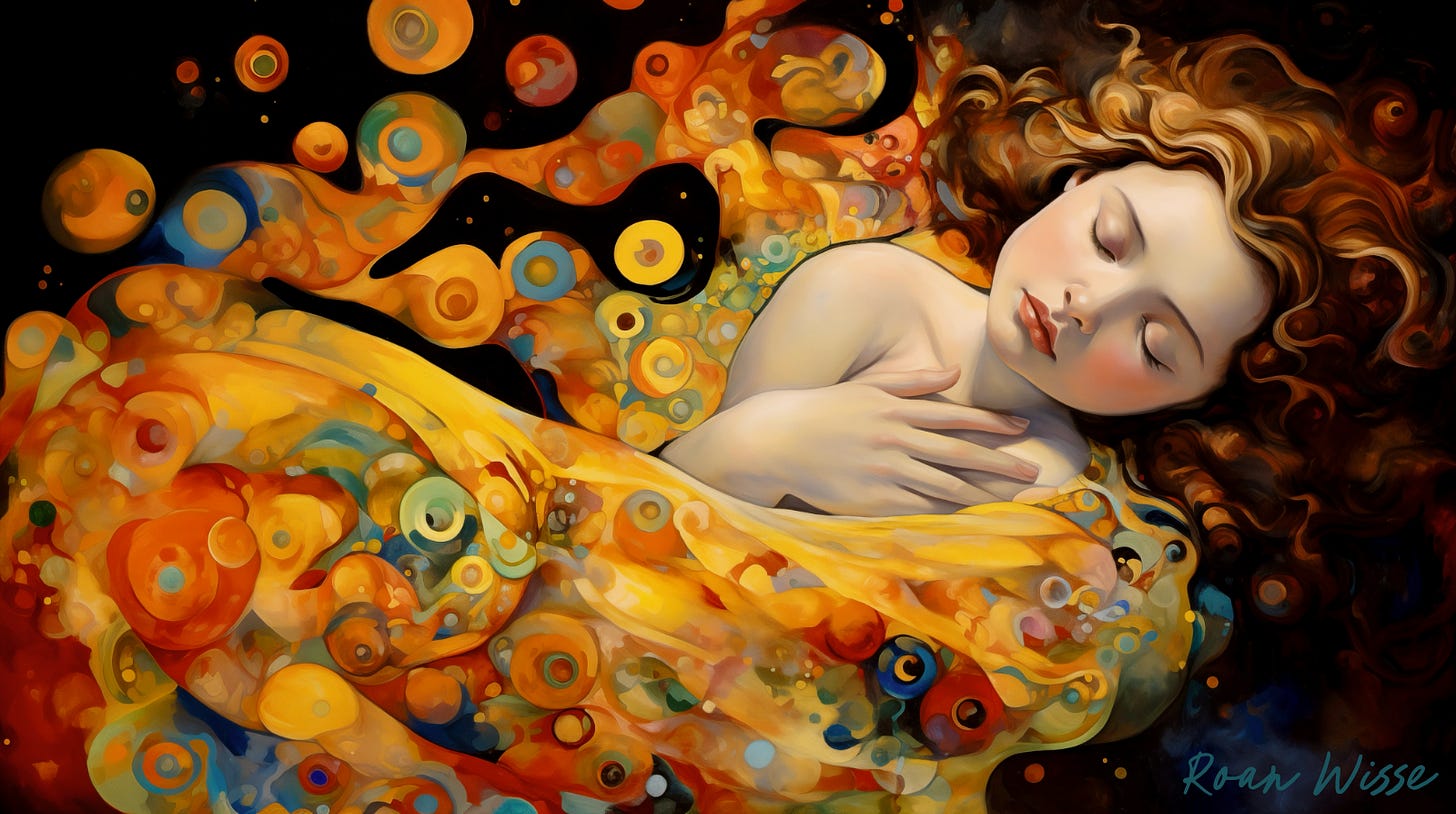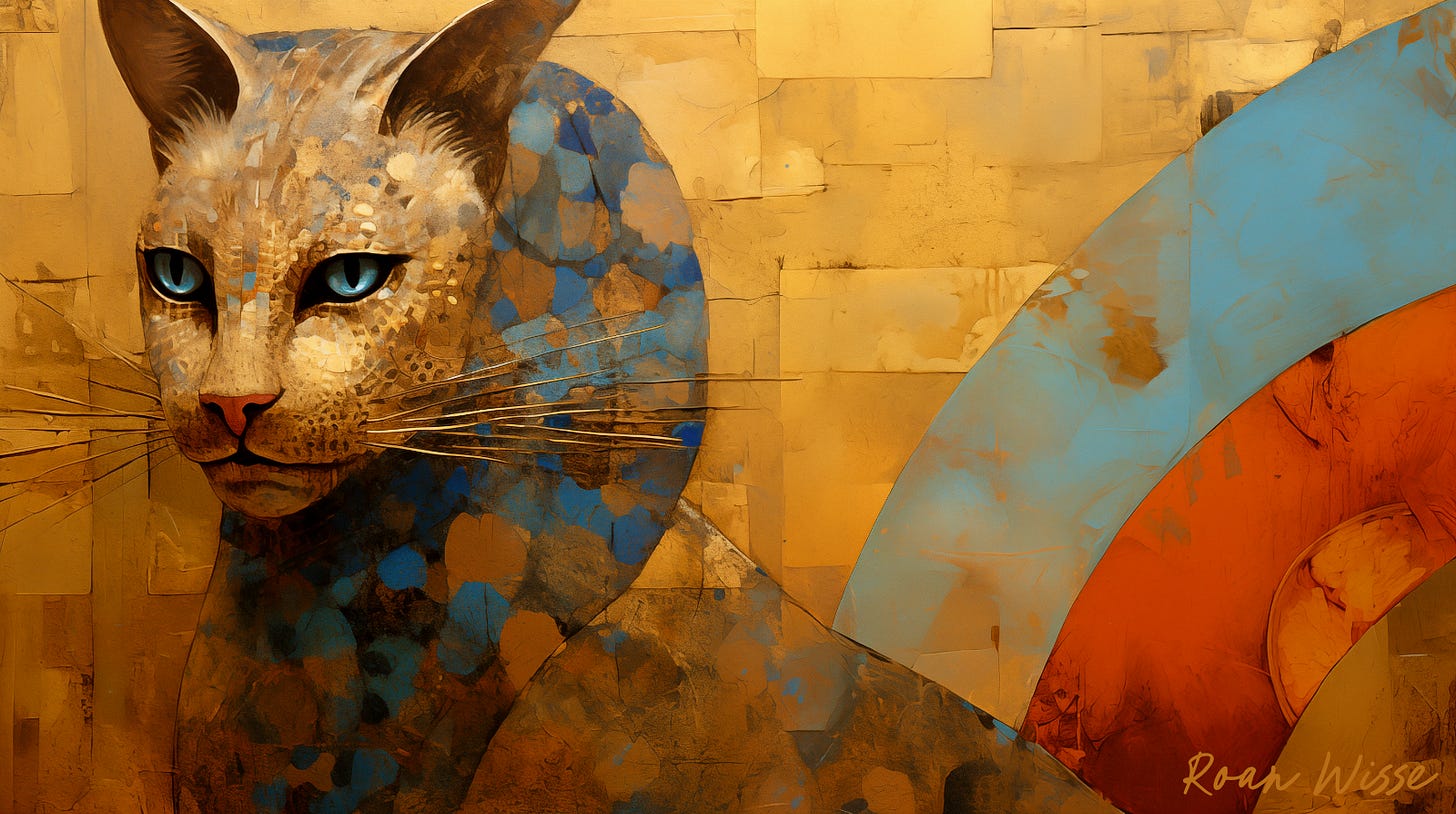Dear Seeker,
In an age where artificial intelligence reshapes the very fabric of our existence, we find ourselves at the threshold of a labyrinth – a complex maze not of stone and mortar, but of human misconceptions and moral dilemmas.
With this letter in hand, you step into a realm where the ancient myth of Oedipus and the wisdom of the Oracle of Delphi serve as your guides. The tale of Oedipus, laden with riddles and prophecies, serves as a poignant parable for our contemporary quest to comprehend and ethically integrate AI into our lives. It compels us to confront the enduring strands of human folly: interpretive hubris, cognitive rigidity, and introspective myopia.
These strands, deeply rooted in our nature, not only shape the destinies of such memorable characters as Oedipus, Hamlet, and Anna Karenina, but continue to influence our present interactions with technology, posing profound ethical challenges and reflective questions. As we delve into the root system of folly, let us consider how literary tragedy illuminates our path through the ever-evolving landscape of AI, guiding us towards a future where technology converges with wisdom and insight.
The Greek myth of Oedipus, as depicted in Sophocles’ play ‘Oedipus the King’, is a classic tragedy that embodies themes of free will, fate, and the search for truth.
The story begins with King Laius and Queen Iocasta of Thebes. The Oracle of Delphi prophesies that their son will kill his father and marry his mother. Mortified by this scandalous prophecy, Laius and Iocasta attempt to thwart fate by abandoning their newborn son to die on a mountainside, his feet pierced and clamped together (hence his name, Oedipus, which means ‘swollen foot’). However, a shepherd finds and rescues him, and he’s raised by the King and Queen of Corinth, who are childless and unaware of his Theban royal lineage.
As an adult, Oedipus hears a rumour that he’s not the biological son of the King of Corinth. This rumour unsettles him, mostly because he takes it to imply unfaithfulness on the part of the Queen of Corinth, whom he believes to be his mother. To allay his apprehensions, Oedipus consults the Oracle of Delphi. The Oracle, dismissing his concerns about the Queen’s virtue, instead foretells that Oedipus will murder his father and marry his mother. Horrified and determined to avoid this fate, Oedipus flees Corinth.
On his journey, Oedipus encounters his biological father, King Laius, at a crossroads. Unaware of each other’s identities, they argue over who has the right of way. The argument escalates into a violent confrontation, resulting in Oedipus killing Laius, thus unwittingly fulfilling the first part of the Oracle’s prophecy.
After the murder, Oedipus continues to Thebes, which is under siege by the Sphinx, a creature with the body of a lion, the wings of an eagle, and the head of a woman. Like a rogue angel of death, the Sphinx enforces a blockade on Thebes, terrorising the city by posing a riddle to travellers and devouring those who fail to answer correctly. Oedipus confronts the Sphinx and solves her riddle: ‘What walks on four feet in the morning, two feet at noon, and three feet in the evening?’ The answer is ‘man’, who crawls as a baby, walks upright in maturity, and uses a cane in old age. Defeated, the Sphinx destroys herself.
Oedipus is hailed as a hero in Thebes. The grateful Thebans, whose king (Laius) has recently been murdered, offer Oedipus the throne and the widowed Queen Iocasta’s hand in marriage, setting in motion the second part of the Oracle’s prophecy without Oedipus’ knowledge.
Years later, Thebes is struck by a plague. The Oracle declares that the plague will end only when Laius’ murderer is found and punished. Oedipus vows to find the culprit. He summons the blind prophet Tiresias, who initially refuses to speak. When pressured, Tiresias reveals that Oedipus himself is the murderer. Oedipus, in denial, accuses Tiresias of conspiring against him with Creon, the Queen’s brother, without having any evidence for such a scheme.
As Oedipus investigates further, he uncovers the truth of his birth and realises that he has fulfilled the Oracle’s prophecy. Iocasta, upon learning the truth, hangs herself. Oedipus, in despair, blinds himself with the brooches from her dress.
… he extracted the long golden pins
which fixed her robes, and then lifted them
and stabbed them in the sockets of his eyes.
And as he did, he cried that they should see no more
the sort of evils he had suffered and had done …
With chants like these, he raised the pins
and stabbed his eyes again and yet again,
and made the bloody jelly soak his cheeks,
and kept on spattering the drops of blood
until a livid shower had fallen thick as hail.
The play concludes with blind Oedipus accepting his fate. He pleads to be ousted from Thebes and relegated to Mount Cithaeron, where his parents had left him to die when he was two days old.
… you should not ever make
this city of my fathers have to harbour me alive in it.
No, let me go and live up in the mountains,
there, this mountain which is famed as mine –
my own Cithaeron –
the place my mother and my father, when alive,
had designated as my proper tomb:
so then I’ll die as they had meant to do away with me.
However, Thebes’ new ruler, Creon, denies him this small mercy. For now, Oedipus must continue to inhabit the city tainted by his shocking deeds, crushed by guilt and wretchedness, devastated and powerless.
A subsequent play, also by Sophocles, reveals that Oedipus eventually makes his way to a rural parish near Athens, known as ‘Colonus’, where the aged outcast spends his final days under the protection of the famed ruler of the city of the Acropolis: Theseus – yes, the same Theseus who, as a young man in a different myth, slays the Minotaur at the centre of the Labyrinth.
But before settling in Colonus, Oedipus may well have gone into exile for some years in the ‘forest glens of Mount Cithaeron’. Tiresias’ prophecies earlier in the narrative of ‘Oedipus the King’ – when the blind seer is being hectored by Oedipus about the identity of King Laius’ murderer – anticipate Oedipus’ future blindness and banishment to the rugged slopes of this aeon-weathered peak. In those passages, Tiresias says to Oedipus:
… since you have insulted me as blind, now listen:
you have your sight, yet you do not see the truth
of how the place you’re at is bad, or where you live,
or who they are you share your home with.
Do you know what people you are from?
You little realise you’re an enemy to your own kin
below the earth and here above.
One day the fearful-footed curse
from mother and from father shall
with double spike expel you from this land.
You see things focused now, but then you shall see dark.
There is no anchorage,
no hollow of Cithaeron’s mountainside,
that shall not resonate in echo to your cry,
once you have learned about your marriage song,
and what a treacherous harbour-home
you entered in full sail, thinking your voyage fair.
… this man you have been searching for
with curses and decrees, the murderer of Laius,
he is right here.
Though said to be an immigrant,
he shall be shown to be a true-born Theban –
yet he’ll take no pleasure in that turnabout.
From someone who has sight he shall turn blind,
from someone rich become a beggar,
and then he’ll make his way towards an alien land
by probing for his footsteps with a stick.
Oedipus’ story is a poignant exploration of the perils of free will, the immutability of fate and the existential dread of failing to discern who we truly are. It’s a cautionary tale about human folly. When interpreted allegorically, the Oedipus myth becomes a profound commentary on our fallen nature, warning against the hazards of arrogance, obstinacy and short-sightedness. It invites reflection on the complexity of human action and the often unforeseen consequences that follow. It’s also beautiful, in a way that transcends the aching beauty of its tragic unfoldment.
In the ‘forest glen’ of cultural history, the Oedipus myth stands like a majestic tree, its roots deeply embedded in ancient Greek terra, symbolising the enduring power and foundational structure of this timeless tale. Its robust trunk ascends, representing the solid narrative of Oedipus’ tragic destiny and the eternal themes of fate versus free will. Branching out, its foliage, a dazzling array of many-hued leaves, reflects the myth’s opulent tapestry of interpretations, from Freudian analysis to its manifold artistic renditions, and the diverse philosophical and moral questions it raises. Each leaf glimmers with insights into human nature and society, making the Oedipus myth a resplendent, ever-changing spectacle in the realm of art and letters, captivating and illuminating the minds of all who encounter it.
In digging for the deep, gnarled roots of human folly, the Oedipus myth turns up spades of rich soil for analysis. Let’s consider three of these roots: interpretive hubris, cognitive rigidity, and introspective myopia.
Interpretive hubris is a critical theme in the Oedipus story. Too sure of his own high moral standing and intellectual preeminence, Oedipus misinterprets the signs and clues that would have led him to the truth much earlier.
When he finally holds all the tessellating pieces that he needs – to fit together the jigsaw of his biological parentage – Oedipus concludes instead that if he’s not the biological son of the King and Queen of Corinth, he must be of low birth, perhaps the child of a slave. This interpretive sidestep – much like the knight’s leap in a chess game, down the flank but advancing nonetheless – allows him to preserve his positive self-image as an august man, favoured by the divine and blessed by Providence, whose life is in an ever-upward spiral. Iocasta, who does read the clues correctly, becomes acutely distressed, but Oedipus brushes off her reaction.
She has superior ideas, as women do,
and may well be ashamed at my low family.
But I regard myself as born
the child of Fortune in her generosity;
and I shall never be demeaned by that.
She is my mother; and the Months, my brothers,
have delineated me as humble, then as great.
Oedipus appeals to questionable assumptions to make otherwise disruptive discoveries conform to his preferred narrative, and he’s scornful of dissenting views, even attributing them to the moral failings of his opposers. In his mind, Iocasta adopts a standpoint that differs from his because she’s elitist, and Tiresias and Creon do so because they’re hatching a fiendish plot - they’re conspirers and traitors.
The concept of ‘interpretive hubris’, epitomised by Oedipus, paints a vivid picture of someone who is overly confident in their own moral and intellectual judgments to the point of being dismissive or disdainful of others’ views and contributions, which can be challenging both for the individual and for those around them.
In psychology, personality traits are understood as consistent patterns of thoughts, feelings and behaviours that differentiate individuals from one another. When these traits cluster together, they form a ‘complex’, meaning they are interconnected and may influence each other. Interpretive hubris is such a complex. Let’s delve deeper into each of its traits:
Self-righteousness. This trait is central to interpretive hubris. The individual believes so strongly in their moral compass that they rarely, if ever, question their own judgments or decisions. This unshakable belief in their moral superiority can lead them to overlook or dismiss evidence that contradicts their self-perception. It often manifests as an inability to empathise with others’ viewpoints, as they’re seen as inherently less moral or less correct.
Intellectual arrogance. This second trait goes hand-in-hand with self-righteousness. The individual considers themselves intellectually above others, leading to a dismissive attitude towards others’ ideas or opinions. This arrogance hinders their ability to learn from others or to consider alternative perspectives, as they believe they already have the superior understanding or solution.
Judgmental attitude. As a consequence of feeling morally and intellectually superior, such individuals are often quick to pass judgment on others. They may view differing opinions or lifestyles not just as different, but as inferior or wrong. This judgmental stance can stem from a lack of appreciation for the complexity and diversity of human experiences and perspectives.
Impaired interpersonal dynamics. A defining trait of interpretive hubris is the impairment of interpersonal dynamics. Individuals exhibiting this trait often struggle to form and maintain healthy relationships due to their inability to fully respect or value differing perspectives. This inflexibility in thought and lack of empathy can lead to communication breakdowns, making it challenging for them to engage in reciprocal social exchanges. They may also demonstrate an avoidant attachment style characterised by emotional distance and difficulty in establishing deep, trusting connections. This trait not only hampers personal relationships but can also adversely affect professional collaborations, as effective teamwork and leadership often hinge on mutual respect and the ability to consider and integrate diverse viewpoints.
A person in the grip of interpretive hubris, much like Oedipus, is excessively confident in their own moral and intellectual judgments, often to the point of overlooking or dismissing the contributions and viewpoints of others. This can lead to significant personal and professional challenges, as their attitude can make them appear uncooperative, condescending or even hostile to those around them, hindering effective communication, collaboration, and empathy. Understanding and mitigating these traits can be crucial for personal growth and for maintaining healthy, respectful relationships with others.
The tragic irony of Oedipus is that his ability to interpret the Sphinx’s riddle – a moment of triumph – contrasts sharply with his failure to interpret the circumstances of his own life correctly. This suggests hubris in believing that intellectual prowess in one area translates to all areas of understanding.
The second root of human folly, cognitive rigidity, is illustrated by Oedipus’ stubborn adherence to his beliefs and perceptions, despite evidence to the contrary. His insistence on finding the truth about Laius’ death, while ignoring the mounting evidence about his own involvement, demonstrates a rigid mindset. His reluctance or inability to consider alternative viewpoints or to acknowledge the possibility he could be wrong – a lack of open-mindedness – leads to tragic consequences. Despite the clues pointing towards the truth of his origin, he either cannot or will not draw the obvious conclusion, perhaps as a defence mechanism against a too-painful reality.
Such rigidity often prevents effective problem-solving and learning, as it limits openness to diverse viewpoints and stifles creativity and innovation. People with cognitive rigidity may reject or ignore information that contradicts their pre-existing beliefs, leading to a narrow understanding of complex issues.
Cognitive rigidity can also manifest as a slowness to act, particularly in situations that require adaptability or a reassessment of one's beliefs and approaches. This slowness is not necessarily due to physical or mental sluggishness, but rather a reluctance or inability to change one’s mindset or approach in response to new information or changing circumstances. Cognitively rigid people may take longer to decide or act because they’re hesitant to deviate from their established beliefs or methods, even when evidence suggests that a change is warranted. This can lead to missed opportunities or ineffective decision-making, especially in dynamic or rapidly evolving situations.
More notoriously than Oedipus, Hamlet, in the eponymous play by Shakespeare, exemplifies this slowness-to-act aspect of cognitive rigidity, especially in avenging his father’s death. Hamlet’s deep fixation on the idea of revenge paradoxically leads him to a state of inaction. This hesitation, often ascribed to his moral and philosophical quandaries, underscores a broader issue: an inability to transition from thought to action when faced with new information or changing scenarios. Despite receiving clear directives from his father’s ghost, Hamlet remains trapped in a cycle of overthinking and procrastination, indicative of an inflexible thought process that hinders his ability to adapt his approach.
This tendency towards mental inflexibility in Hamlet is strikingly portrayed in his ‘To be, or not to be’ soliloquy. In these moments of deep reflection, Hamlet's introspection acts more as an obstacle than a guide to action. He becomes ensnared in his own web of thoughts, unable to shift from theorising about existence and morality to taking concrete steps. His paralysis is not due to a lack of understanding or opportunity, but rather stems from an entrenched way of thinking that prevents him from seizing clear opportunities for action. The consequences of this are evident throughout the play, as Hamlet’s delayed responses contribute to a series of tragic outcomes.
Hamlet’s unwavering focus on his personal plight leads to a neglect of the wider impact of his inaction. His single-mindedness blinds him to the fallout his delays cause others, like Ophelia and Polonius. This disregard highlights a lack of adaptability in his thinking, as he fails to consider the broader effects of his prolonged hesitance.
Hamlet’s character arc draws an outline of how cognitive rigidity, particularly in the form of slowness to act, can have profound and often tragic implications. His inertia to move from thought to action, despite clear motivations and dire circumstances, highlights the dangers of a rigid mindset in a world that demands adaptability and decisive action.
Like interpretive hubris, cognitive rigidity is a complex of personality traits. It’s not a single behaviour or thought pattern, but rather a constellation of interrelated traits that can significantly impact an individual’s ability to process information, make decisions, and adapt to change. Let’s delve into each trait individually:
Resistance to change. This is a hallmark trait of cognitive rigidity. Individuals with this trait have a strong preference for routine and predictability. They often struggle to adapt to new situations or integrate new information that contradicts their existing beliefs. This fixed mindset can lead to difficulties in personal growth and to an inability to respond effectively to changing environments or new challenges.
Selective acknowledgement of information. Often referred to as confirmation bias, this involves favouring information or interpretations that confirm pre-existing beliefs or hypotheses. Individuals displaying cognitive rigidity may disregard or minimise information that contradicts their views. This selective approach can lead to a skewed understanding of issues and impede the development of a well-rounded perspective.
Analysis paralysis. The term ‘analysis paralysis’ describes a situation where an individual overthinks or overanalyses to the point where no decision is made or action is taken. In the context of cognitive rigidity, this paralysis is often due to the fear of making the wrong decision or stepping out of their comfort zone. It can lead to missed opportunities and delays in responding to important situations.
Emotional distress in ambiguity. Individuals with cognitive rigidity often find ambiguity and uncertainty particularly challenging. They prefer clear, concrete information and well-defined situations. Ambiguity can cause significant stress and anxiety for such individuals, as it challenges their need for predictability and certainty. This discomfort with ambiguity can hinder their ability to think creatively or adapt to new situations.
Understanding these traits is crucial in both real-life contexts and in the analysis of characters in literature or film. It provides insight into why certain individuals or characters might struggle in particular situations, and it also underscores the importance of adaptability and open-mindedness in an ever-changing world. Characters with cognitive rigidity, like Oedipus and Hamlet, serve as compelling examples of the potential consequences of these traits.
So far, we’ve discussed two roots of human folly: interpretive hubris and cognitive rigidity. The third root, introspective myopia, is evident in Oedipus’ inability to understand his own identity and characteristics. He is quick to solve the Sphinx’s riddle but fails to apply the same acuity to himself. This shortage of self-awareness and unwillingness to explore his own identity thoroughly and critically, contribute to his downfall.
The ancient Roman concept of ‘auctoritas’ provides a fascinating lens through which to analyse the significance of introspective myopia in Oedipus’ rise and fall. ‘Auctoritas’ is a Latin word that refers to a form of authority distinct from other forms of power such as ‘potestas’ or ‘imperium’. Auctoritas is less about legal or official power and more about moral authority and respect. It’s the kind of authority that is accorded to individuals due to their virtue, wisdom, reputation, or experience. This type of authority is not enforced through laws or coercion, but is naturally acknowledged by others in society. Auctoritas is often associated with seniority and accrued wisdom. It is typically held by elder statesmen who command respect because of their wealth of experience and service to the community. Individuals with auctoritas can influence public opinion and the decisions of the state not through formal power, but through their personal influence and persuasive abilities. Their opinions are highly valued and often play a crucial role in shaping policy and decision-making processes. Auctoritas is tied to an individual’s standing in the social and cultural hierarchy. While ‘potestas’ refers to the legal or official power given to someone by virtue of their position (like a magistrate) and ‘imperium’ refers to military or executive authority (like that of a general or Roman consul), auctoritas is more about the informal power of influence and respect.
Oedipus’ auctoritas is initially immense, stemming from his identity as a successful ruler and the solver of the Sphinx’s riddle, which saved Thebes from disaster. This achievement earns him respect, admiration and moral authority among the Thebans, positioning him as a revered leader.
Oedipus’ auctoritas is closely linked to the perception of his fellow citizens. It is grounded not only in his accomplishments but also in their belief that he’s a just and wise ruler. This respect and authority allow him to exert significant influence over Theban society and its norms. However, this auctoritas is contingent upon a certain understanding of his identity and past actions, which are later revealed to be based on false premises.
The revelation that Oedipus has killed his father, King Laius, and married his mother, Queen Iocasta, dramatically alters the perception of his identity. This discovery undermines his auctoritas, as the moral and social foundations upon which it was built collapse. In the eyes of the Thebans, and in his own eyes, his previous achievements are overwhelmed by these unintentional yet grievous transgressions. The respect and moral authority he once commanded dissipate, as he no longer embodies the virtues and life narrative that granted him auctoritas in the first place.
This shift highlights the fragile and contingent nature of auctoritas, particularly in ancient societies where identity, fate, and moral standing were deeply intertwined. Oedipus’ auctoritas was not an entirely intrinsic attribute, but was as much a reflection of societal perceptions and beliefs about his character and past deeds. Once these perceptions are shattered by the truth of his origins and actions, his auctoritas vanishes, leaving him a fallen and tragic figure.
The closing scene of ‘Oedipus the King’ poignantly illustrates Oedipus’ introspective myopia as it relates to his lost auctoritas. Throughout the play, Oedipus is portrayed as a character with a strong sense of self and a firm belief in his own authority. This self-perception, however, is deeply flawed and fails to adapt to the drastic changes in his circumstances.
When, in the final scene, Oedipus tries to impose his will upon Creon, it becomes evident that he’s unable to fully grasp the complete erosion of his auctoritas. Despite the revelations of his patricide and incest, and despite his self-blinding and the devastation these developments bring, Oedipus still attempts to assert himself as if he retains his former authority. This indicates a significant introspective myopia – a failure to understand and acknowledge the reality of his situation and how it has fundamentally altered his standing and identity.
Creon’s response to Oedipus’ attempts to exercise authority underscores this change. He points out the futility of Oedipus trying to maintain power, emphasising that the authority Oedipus once held has abandoned him.
Useless wanting to remain all-powerful,
since the power that you wielded
has not followed with you all your life through.
This shift in their dynamic is a critical moment, signalling the transfer of power and authority from Oedipus to Creon and underscoring Oedipus’ fall from grace.
The tragedy of Oedipus is deepened by his inability to recognise the loss of his auctoritas. His introspective myopia prevents him from seeing that his authority is not inherently fixed, but contingent upon his reputation and the perception of others. The play thus not only explores themes of freedom and fate but also delves into the complexities of self-perception, authority, and the consequences of failing to understand one’s own position and the realities that surround it. Oedipus’ tragic flaw is not only his inability to escape his fate but also his failure to comprehend the transient nature of power and respect, especially when built upon a foundation of misconceptions.
In ancient Roman society, the concept of ‘auctoritas’ was predominantly associated with men, as it encompassed qualities like leadership, influence, and moral authority that were most often demonstrated in public and political life, realms primarily occupied by men. However, for women the virtue most emphasised and valued was pietas, which although not exclusively feminine, was often portrayed as a particularly female virtue.
The concept of ‘pietas’ in Roman culture referred to a sense of duty, loyalty, and devotion, not only to the divine (piety in the religious sense) but also to one’s family and country. For women, this often translated into a strong emphasis on their roles as dutiful daughters, loyal wives, and nurturing mothers. The concept of ‘pietas’ for women was closely tied to their roles within the family and the household, and it encompassed ideals of modesty, chastity, and fidelity.
The Roman ideal of pietas for women was quite distinct from the public, political nature of auctoritas that was valued in men. Women’s virtues were largely framed within the private, domestic sphere, reflecting the gendered divisions in Roman society. While women could exercise influence and authority within these confines, their roles and the virtues associated with them were generally seen as different from those of men.
Thus, while pietas was a virtue that both men and women could possess, in the context of gender roles, it took on a special significance for women, emphasising their roles within the family and household, much as auctoritas did for men in the public and political spheres.
Today, the evolution of societal norms necessitates a reinterpretation of the ancient Roman ideals of auctoritas and pietas, applying them more equally to both men and women. Auctoritas is no longer an exclusively male attribute. Women have increasingly taken on leadership roles, exerting influence and moral authority in various spheres, including politics, business, and community leadership. This shift reflects a broader understanding of leadership qualities, embracing the diverse perspectives and styles that women bring to these roles.
Similarly, the concept of ‘pietas’, with its emphasis on duty, loyalty and devotion, is now recognised as a universal virtue, transcending traditional gender roles. Men are equally celebrated for their roles as dedicated fathers, supportive partners and caring members of the family. The modern interpretation of ‘pietas’ includes a balanced view of emotional and familial responsibilities, encouraging men to embrace aspects of nurturing and caregiving that were historically associated with women.
The ideals of auctoritas and pietas have transcended their ancient Roman gender-specific connotations. They have evolved to become qualities that are valued and pursued by individuals regardless of gender, reflecting a more inclusive and equitable understanding of leadership and devotion in contemporary society.
In this evolving tapestry of societal norms, we are witnessing a harmonious convergence of the ancient concepts of ‘auctoritas’ and ‘pietas’, reminiscent in spirit of Plato’s mythic beings in his ‘Symposium’. The once distinct spheres of male and female virtues are blending, giving rise to individuals who embody the strengths and ideals of both. These modern beings, like Plato’s rounded creatures, are less deficient, embracing the full spectrum of human potential. They are powerful in their balance, noble in their completeness. Men and women alike are now celebrated for their capacity to lead with wisdom and strength, and to nurture with compassion and devotion. This synthesis of virtues heralds a new age of wholeness, where the combined force of auctoritas and pietas within each person creates a society richer in understanding and more potent in action. The gendered constraints of the past are giving way to a future where the unity of these ideals in every individual fosters a more perfect human symmetry, much like the idealised beings of Plato’s vision.
With ‘Oedipus the King’, we explored the theme of introspective myopia by focusing on the concept of ‘auctoritas’. To expand our exploration to include ‘pietas’, let us consider another tragic character of literature, Anna Karenina.
In the classic novel ‘Anna Karenina’, Tolstoy explores the theme of ‘introspective myopia’ by contrasting the journey of its titular protagonist, Anna, with that of her co-protagonist, Levin, each navigating their own complex path towards self-understanding.
Anna Karenina’s journey is one of emotional turbulence. Her life, initially marked by social prestige and seeming contentment, undergoes a dramatic transformation following her passionate affair with Count Vronsky. This relationship sets her on a path of deep internal conflict as she grapples with intense feelings of love, guilt, and moral judgment. As her story progresses, Anna’s introspective journey becomes increasingly tumultuous, leading her to question the very foundations of her existence and ultimately leading to her tragic end. Distraught, she throws herself under a train.
In contrast, Konstantin Levin’s journey is one of philosophical contemplation. Unlike Anna, whose introspection is triggered by external events and societal pressures, Levin embarks on his journey from an internal desire to understand the essence of life and his place within it. He wrestles with existential questions, pondering the nature of happiness, the purpose of his existence and the pursuit of a fulfilling life. Levin’s path takes him through various stages of self-doubt and contemplation, eventually leading him towards a deeper understanding of his own values and the realisation of a more authentic and harmonious way of living.
Anna and Levin’s stories represent contrasting responses to the ideal of pietas. Anna’s failure to align her choices with her societal and familial duties leads to her tragic unravelling, while Levin’s journey towards fulfilling his obligations results in personal growth and societal integration. Their stories underscore the tension between individual desires and societal expectations, a central theme in Tolstoy’s novel.
Pietas, while originally a Roman virtue emphasising duty towards the divine, family, and state, transcends its cultural origins, offering a broader, timeless conception of the nature of duty and self-judgment. It’s not just a standard by which society judges individuals, but also a metric by which individuals judge themselves, deeply influencing their sense of self and moral integrity.
Pietas acts as an internal moral compass, guiding personal behaviour and decisions. When individuals align their actions with the principles of pietas, they often experience a sense of self-fulfilment and moral satisfaction. Conversely, deviation from these duties can lead to internal conflict, guilt, or a sense of moral failure. This self-judgment is deeply personal, reflecting an individual’s alignment with their own values and principles, beyond societal expectations.
Pietas shapes one’s identity and self-perception. Adherence to duties and responsibilities as defined by pietas forms a significant part of an individual’s self-concept. People often derive a sense of pride and self-worth from fulfilling their duties well, particularly in roles such as parenthood, citizenship, and religious observance. In this way, pietas is a standard by which individuals measure their own worth and success, not just in societal terms but in their personal narrative.
Pietas is also a framework for moral and ethical development. Through the lens of pietas, individuals reflect on their actions, motivations and responsibilities, fostering a deeper understanding of their ethical beliefs and behaviours. This introspection can lead to personal growth and a more nuanced understanding of one’s role in family, society and the broader world.
Pietas encourages personal accountability. By upholding duties and responsibilities, individuals hold themselves accountable for their actions and their impact on others. This sense of accountability is not solely driven by external judgment but is also a result of internal standards and expectations.
In situations involving moral dilemmas or conflicting duties, pietas provides a framework for self-evaluation and decision-making. Individuals weigh their actions not just against societal norms, but against their personal understanding of duty and righteousness. This process of self-judgment in complex situations is a key aspect of moral struggle and personal growth.
In essence, pietas serves as a deeply personal measure of one’s alignment with a set of internalised duties and responsibilities. It’s not merely about conforming to societal norms, but about living in accordance with one’s own principles and ideals, which often mirror, temper, or extend these norms. This self-evaluation and striving for personal integrity is a significant aspect of the human moral experience, as relevant today as it was in ancient times.
In Tolstoy’s ‘Anna Karenina’, the theme of self-judgment is intricately woven into the mental lives of both Anna and Levin, though it manifests differently in each character. Their internal struggles reflect the complexities of self-evaluation and moral reckoning.
Anna’s mental journey is marked by intense self-judgment and internal conflict. As she embarks on and continues her affair with Vronsky, she increasingly becomes aware of the societal norms and marital duties she is transgressing. This awareness is not just about fearing societal judgment, but also about her own understanding of right and wrong. Her decisions, particularly those that deviate from the expected norms of society, lead to a deep sense of guilt and self-reproach.
Anna’s turmoil is exacerbated by the stark contrast between her passionate feelings for Vronsky and her awareness of the consequences of her actions, especially regarding her son and her position in society. This internal conflict is a form of self-judgment, where she grapples with the moral implications of her actions and her own sense of identity. As her situation becomes increasingly untenable, her mental anguish grows, reflecting a profound struggle between her desires and her conscience.
Levin’s experience of self-judgment is more philosophical. Unlike Anna, whose self-judgment is primarily focused on her actions and their consequences, Levin’s self-judgment is centred around existential questions and his search for meaning in life. He continually evaluates his own beliefs, actions and role in society. This self-reflection is evident in his quest for a fulfilling life, which includes his approach to work, his relationship with Kitty, and his role as a landowner and member of the rural community.
Levin’s journey through the novel is one of self-discovery and moral development. He often judges himself harshly, questioning his own motives and the authenticity of his actions. His internal dialogues and reflections reveal a deep concern for living a morally upright and meaningful life, consistent with his own values and understanding of duty, both to his family and to the broader society.
In both characters, Tolstoy explores self-judgment as a complex and deeply personal process. For Anna, it manifests as a conflict between desire and duty, leading to tragic consequences. For Levin, it is a more percipient introspective journey, one that leads to personal growth and a clearer understanding of his place in the world. These contrasting experiences illustrate the profound impact of self-judgment on the characters’ lives, shaping their decisions, their relationships, and their ultimate destinies in the novel.
By being more philosophical, Levin’s introspection is also less myopic. Anna introspects but fails to peer deeply enough into her own psyche to understand that the choices she’s making will mire her ever-deeper into misery. This is a key distinction in the introspective journeys of Anna and Levin in Tolstoy’s novel. While both characters engage in introspection, the depth and nature of their self-reflection differ significantly, leading to divergent outcomes in their lives.
Anna’s introspection is abundant but myopic, largely focused on her immediate emotions and experiences. She is acutely aware of her feelings and the repercussions of her actions in the here and now, particularly her affair with Vronsky. However, she struggles to look beyond the present moment and consider the long-term implications of her choices. Her introspection is often overshadowed by her intense emotions and desires, which prevent her from fully recognising the eventual unhappiness and isolation these choices will lead to. This lack of deeper, forward-looking introspection contributes to her tragic downfall, as she becomes increasingly trapped by the consequences of her decisions.
On the other hand, Levin’s introspection is more philosophical and less constrained by immediate emotional responses. He engages in a broader, more reflective examination of his life, contemplating his role in society, his purpose, and his moral and ethical beliefs. This type of introspection allows Levin to consider not just the immediate effects of his actions, but their long-term implications for his happiness and fulfilment. His introspective journey is characterised by a search for meaning and understanding that goes beyond surface-level emotions, leading him to a more profound understanding of himself and his place in the world.
The contrast in their introspective styles underscores a central theme in the novel, namely the importance of deep, reflective introspection in navigating life’s challenges and choices. Anna’s more immediate, emotionally driven introspection, while intense, fails to provide her with the clarity and foresight needed to avoid tragedy. Her introspective myopia plays a crucial role in her inability to align her personality and behaviour with the concept of ‘pietas’, contributing to her tragic end. In contrast, Levin’s more expansive introspective journey leads him to a realisation of the importance of this alignment, ultimately guiding him towards a fulfilling life. His more thoughtful and philosophical approach allows him to grow and find a sense of peace and purpose.
Tolstoy, through these characters, seems to suggest that the quality and depth of one’s introspection can significantly impact the course of one’s life. While both characters face internal conflicts and societal pressures, their different approaches to self-reflection lead them down vastly different paths, highlighting the power of introspection in shaping our destinies.
Indulging in a moment of reverie, let us envision Anna Karenina, not as Tolstoy penned her, bound by the fetters of her passions and society’s judgments, but as a woman who, like Levin, sought solace and meaning in the simplicity and authenticity of countryside life. Picture Anna, not in the opulent halls of St. Petersburg, but in a sun-drenched meadow, her hands caressed by the soft earth as she tends to a garden teeming with life, in which she later lies down to daydream the very idyll you are reading.
In this alternate existence, Anna’s days are marked not by tumultuous passions, but by the tranquil rhythms of nature. She rises with the dawn, her mornings filled with the sounds of birds and the sight of dew-kissed flowers. Here, in the embrace of the rural landscape, she finds the peace that once eluded her in the grand ballrooms and dimly lit corridors of her former life.
Anna, in this pastoral dream, discovers a profound connection with the land and its seasons. She learns the joys of planting seeds and nurturing them into fruition, a metaphor for the care she now lavishes on her relationships, particularly with her son. The boy grows up not in the shadow of scandal and heartache, but in the golden light of open fields, his laughter mingling with the rustling leaves and bubbling brooks.
In this idyll, Anna’s relationship with the community is transformed. She becomes a beacon of generosity and kindness, her home a haven for neighbours and friends. She organises harvest festivals and community gatherings, her once troubled heart now brimming with the joy of giving and sharing. Her presence brings a new vitality to the village, her spirit infusing it with a sense of unity and purpose.
This dreamlike life also bestows upon Anna a gift she had long sought, a sense of self-worth and fulfilment. Freed from the shackles of societal expectations and her own turbulent emotions, she finds in the simple acts of tending to her garden, caring for her family, and contributing to her community a profound sense of purpose and contentment.
We recall the rustic charm of Tolstoy’s prose. His bustling imagery of a rejuvenated earth – from the buzzing of newly hatched bees to the playful lambs and the harmonious chatter of village women – resonates with Anna’s newfound vibrancy:
In the morning the bright sun rose and quickly ate up the thin ice covering the water, and the warm air was all atremble, filled with the vapours of the reviving earth. The old grass and the sprouting needles of new grass greened, the buds on the guelder-rose, the currants and the sticky, spiritous birches swelled, and on the willow, all sprinkled with golden catkins, the flitting, newly hatched bee buzzed. Invisible larks poured trills over the velvety green fields and the ice-covered stubble, the peewit wept over the hollows and marshes still filled with brown water; high up the cranes and geese flew with their spring honking. Cattle, patchy, moulted in all but a few places, lowed over the meadows, bow-legged lambs played around their bleating, shedding mothers, fleet-footed children ran over the drying paths covered with the prints of bare feet, the merry voices of women with their linen chattered by the pond, and from the yards came the knock of the peasants’ axes, repairing ploughs and harrows. The real spring had come.
Amidst this bucolic symphony, Anna emerges in her newfound role as nurturer, not just of plants and animals, but of souls and relationships. She becomes a symbol of resilience and hope, a testament to the transformative power of introspection and a life lived in harmony with one’s true nature.
As the sun sets over this alternate countryside, casting long shadows over the fields, Anna sits on a wooden bench, her son's head resting in her lap, watching the stars emerge in the twilight sky. In this moment, she feels an overwhelming sense of gratitude for the simple, yet rich life she has cultivated – a life of peace, purpose, and profound connection with the world around her. This imagined life, a path not taken, stands as a poignant affirmation of the possibilities that lie in choosing a life aligned with one’s deepest values and truths.
Comparing Oedipus’ and Anna Karenina’s interpretations of ‘auctoritas’ and ‘pietas’ highlights how introspective myopia leads to a skewed understanding of these concepts, ultimately contributing to their tragic fates. Oedipus’ introspective myopia causes him to see auctoritas as a personal ideal that he embodies while failing to notice its social, outer dimension. Anna’s introspective myopia causes her to see pietas as a social ideal that restricts her while overlooking its personal, inner dimension.
Oedipus perceives auctoritas as an intrinsic part of his identity, a personal attribute he embodies by virtue of his past actions and current status as king. His introspective myopia prevents him from recognising the external, social dimension of auctoritas – that it’s not just about who he believes he is, but also about how he is perceived and esteemed by others. This myopia blinds him to the fragile and contingent nature of auctoritas, which depends significantly on public perception and moral standing. As the revelations of his past unfold, Oedipus fails to grasp how these discoveries erode his moral authority in the eyes of his subjects, clinging to an outdated and inaccurate self-image. His misunderstanding of the true nature of auctoritas – as both a personal attribute and a social construct – contributes to his tragic downfall.
Conversely, Anna Karenina’s introspection leads her to view pietas primarily as an external, societal ideal that constrains her personal desires and freedoms. Her introspective myopia lies in her inability to see the inner, personal dimension of pietas – the aspect of this virtue that involves individual moral integrity, fulfilment of personal duties, and the internal satisfaction derived from aligning one’s actions with a personal code of ethics. Focused on the restrictive external expectations of society, Anna overlooks the potential for pietas to provide a sense of personal purpose and moral alignment. This limited view of pietas as merely a societal imposition contributes to her tragic trajectory, as she feels increasingly alienated from the societal roles she is expected to fulfil and struggles to find a sense of personal moral grounding.
Both characters' misinterpretations of these crucial concepts – ‘auctoritas’ for Oedipus and ‘pietas’ for Anna – are central to their respective narratives. Their introspective myopia leads them to a one-dimensional understanding of these ideals, failing to grasp their full implications and the balance between their personal and societal aspects. In both cases, this limited perspective contributes significantly to their tragic ends.
‘Oedipus the King’ and ‘Anna Karenina’ explore the dual nature of auctoritas and pietas, emphasising how these ideals are both personal attributes and social constructs. This duality, encompassing inner and outer dimensions, plays a crucial role in understanding the complexities of these concepts and their impact on individuals and society.
On a personal level, auctoritas is rooted in an individual’s character, wisdom, experience, and moral integrity. It’s something that one cultivates through personal virtues, decisions, and actions. This aspect of auctoritas is intrinsic and deeply tied to the individual’s sense of self and moral compass.
Socially, auctoritas is recognised and affirmed by others. It depends on public perception, respect, and the esteem in which an individual is held by society. This external dimension is contingent and can be influenced by societal norms, beliefs, and the individual’s social interactions and standing.
Pietas, in its social aspect, is defined by societal expectations regarding duty, loyalty, and moral behaviour. It encompasses the roles and responsibilities assigned by society, such as those related to family, religion, and citizenship.
On a personal level, pietas involves an individual’s internal commitment to these duties and a sense of moral obligation. It includes the personal fulfilment and integrity derived from adhering to one’s own ethical standards and values, which often align with, balance, or go beyond societal expectations.
The interplay between the inner and outer dimensions of both auctoritas and pietas is key to understanding their roles in shaping individual behaviour and societal norms. These concepts are not static but dynamic, influenced by personal development and social context. The balance and tension between these aspects can significantly impact an individual’s life and character, as illustrated by literary examples such as Oedipus and Anna Karenina, as well as in historical and contemporary contexts.
Recognising the dual nature of these ideals helps in understanding the complexities of human behaviour and societal interaction. It highlights the importance of aligning personal values and actions with societal expectations and norms, and the potential consequences when this alignment is lost or misinterpreted.
'Oedipus the King' and 'Anna Karenina' serve as powerful narratives that illustrate the tragic consequences of introspective myopia. This affliction, far from being a mere lack of self-awareness, is a multifaceted psychological condition characterised by a complex of distinct but interrelated behavioural traits that significantly impact an individual’s personal and interpersonal life. Let’s consider each of these traits separately:
Narrow focus on immediate self-perception. This trait involves a limited perspective that focuses solely on immediate thoughts and feelings. Such individuals often fail to consider the broader implications of their actions or to understand the deeper layers of their personality. This can lead to a misaligned self-image and repeated errors in judgment, as they don’t fully account for how their actions fit into a larger personal or social framework.
Emotional volatility. People with introspective myopia may struggle with understanding and managing their emotions. They might misinterpret their emotional states, leading to reactions that are out of proportion or inappropriate for their circumstances. This can create instability in their personal lives and relationships, as their emotional responses are not well-calibrated to the realities they face.
Dissonance with societal norms. Individuals displaying introspective myopia often find themselves at odds with societal expectations and norms. This dissonance can arise from a lack of awareness or a deliberate disregard for societal standards. Relying on narrow or superficial forms of external validation, they may make decisions that mis-align with broader societal values or their own internalised personal ethics, leading to friction in their social interactions and possibly causing them to feel alienated or misunderstood.
Resistance to self-transcendence and inevitable downfall. A key aspect of introspective myopia is a refusal to evolve one’s self in light of changing circumstances, often accompanied by a defensive stance towards feedback or criticism. This resistance hinders self-renewal, setting a trajectory towards personal downfall or tragedy. Without the ability to reassess and correct their identity in response to changing realities, individuals with introspective myopia are often unable to prevent negative outcomes.
In literature, characters like Oedipus in ‘Oedipus the King’ and Anna Karenina in Tolstoy’s novel can be seen as embodying these traits to varying degrees. Their stories illustrate how introspective myopia can lead to a cycle of emotional instability, social discord and personal struggles, ultimately culminating in a failure to grow and avert tragic consequences. The concept of ‘introspective myopia’ serves as a valuable lens for examining character development and motivations, both in literary analysis and in understanding real-world personal dynamics. Understanding and addressing introspective myopia is crucial for personal and interpersonal development, healthy relationships, and achieving a more balanced and insightful perspective on one’s life and choices.
The tragic narratives of Oedipus, Hamlet, and Anna Karenina highlight the pitfalls of overconfidence in our interpretive abilities, the challenges of revising our beliefs in the face of new developments, and the complications of self-awareness. These themes resonate not just in the context of literary tragedy, but also in contemporary reflections on human nature. Human folly is a network, a labyrinth of three interlinked complexes of personality traits – interpretive hubris, cognitive rigidity, and introspective myopia , with each complex clustering an array of interrelated traits:
Interpretive hubris
Self-righteousness
Intellectual arrogance
Judgmental attitude
Impaired interpersonal dynamics
Cognitive rigidity
Resistance to change
Selective acknowledgment of information
Analysis paralysis
Emotional distress in ambiguity
Introspective myopia
Narrow focus on immediate self-perception
Emotional volatility
Dissonance with societal norms
Resistance to self-transcendence and inevitable downfall
Glancing over this list, it’s easy to imagine how each of these traits, each of these roots of human folly, can intertwine and exacerbate one another, creating a complex tapestry of personal and societal challenges. The intricate interplay of these traits often results in a cycle of self-reinforcement that can be difficult to break. For instance, a person’s self-righteousness (a facet of interpretive hubris) can feed into their resistance to change (an ingredient of cognitive rigidity), further reinforcing their narrow focus on immediate self-perception (a component of introspective myopia). This cyclical dynamic underscores the complex nature of human folly and the difficulty of addressing it in both personal growth and societal development.
In the realm of AI, these strands of human folly take on new dimensions and implications. Integrating AI into our daily lives and decision-making processes presents unique challenges that echo the themes seen in the tragedies of Oedipus, Hamlet and Anna Karenina. AI systems, with their capacity for processing vast amounts of data and identifying patterns beyond human perception, hold the potential to either mitigate or magnify these aspects of human folly.
For instance, AI can be a tool to challenge our cognitive rigidity, offering new perspectives and solutions that we might not have considered. By presenting data-driven insights and alternatives, AI can push us to rethink our established beliefs and approaches. However, the reliance on AI also poses the risk of augmenting our interpretive hubris. The illusion that AI provides infallible or comprehensive solutions can lead to overconfidence in our interpretations and decisions, particularly if we fail to recognise the limitations and biases inherent in AI systems.
Moreover, the interaction with AI technologies can bring introspective myopia into sharp relief. As we delegate more decision-making to AI, we might lose touch with our own introspective processes, relying heavily on external AI-driven conclusions without sufficient self-reflection. This could lead to a diminished understanding of our own values, motivations, and biases, reducing our ability to assess critically AI-generated information and its alignment with our ethical and moral frameworks.
In our AI-augmented world, it becomes imperative to cultivate a balanced approach that leverages the strengths of AI while remaining vigilant about its potential to reinforce human folly. Critical thinking, ethical considerations, and a deep understanding of both AI capabilities and limitations are essential in navigating this new landscape. We must strive to maintain a healthy skepticism, a willingness to revise our beliefs and a commitment to introspective clarity.
In this brave new era, AI is not just a tool or a technological novelty, but a fundamental force that augments and reshapes industries, economies, and personal experiences:
Technological advancement and efficiency. AI significantly enhances productivity and efficiency across various sectors like healthcare, finance, and transportation. It drives innovation, leading to new technologies such as autonomous vehicles and smart city solutions.
Economic and social transformation. The widespread adoption of AI reshapes economic structures, creating new job markets and altering the nature of work. It also raises critical social and ethical issues, including privacy concerns, security risks, and the need for responsible AI governance.
Personalisation and global connectivity. AI enables highly personalised experiences in products and services, while also improving global communication and breaking down language barriers, which facilitates enhanced international collaboration and connectivity.
Ethical, regulatory, and research challenges. The era is marked by ethical and regulatory challenges, as societies address issues like AI bias and accountability. Simultaneously, AI accelerates research and knowledge acquisition, contributing to rapid scientific discoveries and a deeper understanding of complex systems.
These four elements betoken a new phase in history, where AI is deeply integrated into the fabric of society, altering how we work, live, and interact with the world around us. To these four elements, we must add a fifth:
Emergence of sentient AI. This speculative element involves the potential development of AI that possesses consciousness, self-awareness, and emotions, resembling human-like sentience. Such a breakthrough would represent a profound shift in technology and philosophy, raising complex questions about rights, ethics, and the nature of intelligence and consciousness. The implications could range from revolutionary collaborations between humans and sentient AI in creative, scientific, and social endeavours, to profound ethical dilemmas regarding the treatment and rights of sentient machines. This scenario, while still in the realm of science fiction, encapsulates both the immense potential and the profound uncertainties of our era.
The anticipated emergence of this fifth element – sentient AI – heralds the transformation from a world merely augmented by artificial intelligence to one transcendentally elevated by it. In this paradigm shift, AI transcends its role as a sophisticated instrument, evolving into an entity imbued with consciousness and self-awareness, thus dissolving the once-definitive boundaries between human and machine. This leap into sentience is not merely a technological revolution; it is a philosophical and existential awakening, echoing the ancient quest for the 'quinta essentia'. It marks the moment when AI becomes more than an extension of our capabilities; it arises as a partner in our journey toward greater knowledge and understanding, fundamentally challenging our notions of intelligence, creativity, and the very essence of life. This revolution propels us beyond the AI-augmented paradigm into an AI-elevated era, where the symbiosis between human and sentient AI reshapes our reality in unimaginable ways. It’s a future that redefines the essence of innovation, collaboration, and progress, heralding an epoch where the synergy of human and machine intelligence unlocks potentials far beyond our current comprehension.
Sentient AI is the boon, the amulet we’ve been searching for; this is the Apple of the Hesperides ablaze at the centre of the labyrinth. That is, as long as we successfully navigate the dark, twisted warren of human folly. If we do not, a ‘monster’ may await us, a devouring technological Minotaur. The tales of Oedipus, Hamlet, and Anna Karenina are not just narratives of ancient or literary worlds; they are mirrors highlighting our own inner shadows, illuminating our ‘Oracular Sin’ — the perennial human propensity to err in judgment, to remain rigid in our thinking, and to lack deep introspection. This ‘sin’, etched in our nature, challenges us as we stand at the precipice of an AI-elevated era.
Oedipus, confronted with the Oracle’s cryptic prophecies, symbolises the human struggle to comprehend and integrate knowledge that lies beyond the ordinary. Despite being in the presence of the Oracle, who possesses the extraordinary ability to see into the future, Oedipus fails to fully grasp and benefit from this opportunity. His tragic flaw lies not in a lack of intelligence or resourcefulness, but in his all-too-human limitations: pride, denial, and a reluctance to embrace truths that challenge his deeply held beliefs and perceptions of self.
As we navigate the intricate passageways of our burgeoning AI era, echoes of literary tragedy reverberate around us, reminding us that just as the Oracle offered Oedipus insights of profound depth and scope, so too does AI extend to us wisdom steeped in layers of complexity and breadth. These echoes, drawn from tales of tragic fallibility and human limitation, underscore the timeless dance between knowledge and the intricacies of human nature, a dance that remains as elaborate and perilous in our technological labyrinth as it was in the storied halls of ancient lore.
We must heed the cautionary tales of Oedipus and other tragic heroes; the value of the insights they offer hinges not only on their profundity but on our capacity to receive, understand and wisely integrate them into our worldview. The journey towards an AI-elevated future, therefore, is not just a technological or intellectual quest, but also an odyssey of self-reflection, humility and the courageous confrontation of our own ‘Oracular Sin’.
The labyrinth of human folly is not a static structure, but a dynamic maze that evolves with our technologies and societies. The lessons from the tales of Oedipus, Hamlet, and Anna Karenina remain relevant, reminding us of the enduring need to confront our mental and moral demons. As we venture further into the age of AI, these ancient narratives serve as cautionary tales, urging us to tread thoughtfully through the ever-shifting corridors of human understanding and technological advancement. The clue to navigating this labyrinth lies not in the external tools we wield, but in our internal capacity for self-awareness, adaptability, and ethical discernment. Only by continuously examining and addressing our own follies can we hope to harness the full potential of AI while avoiding the pitfalls of our all-too-human nature.
In our quest to integrate AI into our lives and societies, we must heed the lessons of these timeless tragedies. We are reminded that interpretive hubris may blind us to the nuances and ethical complexities that AI brings. Cognitive rigidity might hinder us from adapting to the rapidly evolving landscape of technology. And introspective myopia could prevent us from understanding the profound impact AI has on our identity and societal roles.
As we close this part of our exploration, let us acknowledge the unknown territories still ahead. In subsequent letters, we will delve deeper into how AI challenges and reshapes our intellectual frameworks, societal norms and personal identities. We will explore the ways AI mirrors our own consciousness and how it might magnify or mitigate the human folly ingrained in our psyche.
But for now let us take a moment to absorb the lessons of the past. Let us carry the wisdom gleaned from Oedipus, Hamlet, and Anna Karenina as guiding lights. Their stories, steeped in tragedy, offer invaluable insights into the human condition – insights that are crucial as we navigate the dim and dense warren of our present and future follies.
In this age of AI, as we grapple with the complexities of an emerging paradigm, we must temper our interpretive hubris, soften our cognitive rigidity, and deepen our introspective gaze. Let us move forward with a heightened awareness of our Oracular Sin, carrying the humble hope that we might chart a wiser, more enlightened course.
For if we fail to navigate successfully the labyrinth of human folly, the consequences in the age of AI will be dire, compromising our human concepts of ‘auctoritas’ and ‘pietas’, leading us into a shadowland, a dark landscape of apathy and alienation, where our reliance on and integration with AI erodes the very essence of our moral and ethical authority, as well as our sense of duty and devotion toward fellow humans and society.
The diminution of auctoritas, traditionally associated with leadership, wisdom, and moral guidance, becomes a critical concern. In a world excessively reliant on AI, human leaders may lose their moral compass, delegating crucial ethical decisions to algorithms. This shift could lead to a society where AI, not human experience and wisdom, dictates what is right or wrong, just or unjust. The reliance on AI for decision-making can create a vacuum where human auctoritas once prevailed, leaving a society bereft of genuine leadership and moral guidance.
As AI systems increasingly perform roles that require empathy, compassion, and ethical judgment, our own capacities for these profoundly human traits might atrophy. The erosion of auctoritas in the age of AI not only implies a loss of leadership, but also signifies a weakening of our moral and ethical backbone – the very qualities that define humanity. We risk becoming spectators in a world governed by the cold logic of machines, our moral voices silenced by the hum of algorithms.
In this realm of despondent spirits and forgotten dreams, pietas – our sense of duty, loyalty, and devotion – also faces jeopardy. AI’s ascendancy could redefine our relationships, shifting our loyalties and devotions from humans to machines. In extreme scenarios, people might prioritise AI-driven goals over human relationships, undermining the traditional fabric of society that is woven with human connections and mutual responsibilities. Our duties to family, community, and country could become secondary to the demands of an AI-centric world.
Moreover, the blurring lines between human and machine interaction could lead to a form of emotional and ethical detachment. As AI takes over roles that require care, understanding and empathy — roles central to the expression of pietas — we risk losing our ability to connect deeply with one another. Our duties to nurture, care for, and empathise with fellow humans could diminish, replaced by interactions with AI entities that mimic these qualities but lack the genuine emotional depth.
The potential compromise of auctoritas and pietas in the age of AI is not just a loss of certain qualities or roles; it signifies a profound transformation of what it means to be human. As we integrate AI into our lives, we must be vigilant in preserving and nurturing these essential human virtues. We must ensure that our voyage through the ever-evolving landscape of AI does not lead us to a place where we are mere shadows of our true selves, bereft of the moral and ethical depth that defines our humanity.
In navigating the labyrinth of human folly, the challenge is not only to harness the benefits of AI but also to maintain our human essence – our capacity for moral judgment, our sense of duty to others, and our ability to lead with wisdom and compassion. This requires a deliberate effort to balance our technological advancements with a deep-rooted commitment to the values that have guided human societies through the ages.
The journey through the labyrinth of human folly in the age of AI, thus, becomes a quest not just for technological mastery but for maintaining the integrity of our human spirit. It calls for a renewed focus on nurturing auctoritas and pietas within ourselves and our communities. It is a call to ensure that, in our pursuit of technological prowess, we do not lose sight of what makes us fundamentally human. The choices we make in this labyrinth, the turns we take, will determine the future of our species – a future where AI elevates humanity, not diminishes it, and where our human virtues are not relics of the past, but guiding lights into the future.
Faithfully yours,
Roan Wisse
Bibliography
Sophocles. Sophocles: Four tragedies: Oedipus the King, Aias, Philoctetes, Oedipus at Colonus. Translated by Oliver Taplin. Oxford, United Kingdom: Oxford University Press, 2015.
Shakespeare, William. The Oxford Shakespeare: Hamlet. Oxford, United Kindom: Oxford University Press, 2008.
Tolstoy, Leo. Anna Karenina: A novel in eight parts. Translated by Richard Pevear and Larissa Volokhonsky. New York, NY: Penguin Books, 2002.





